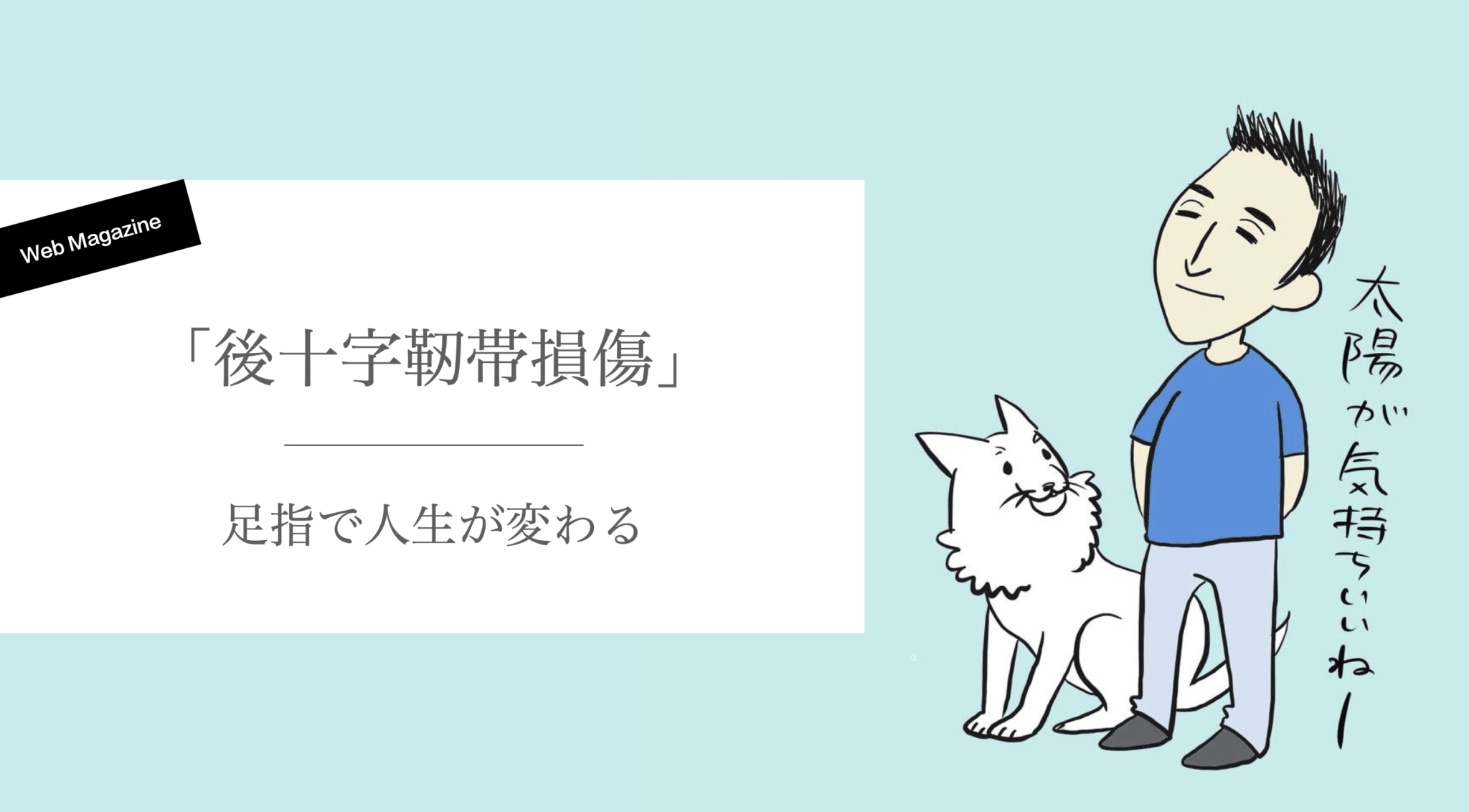足指ドクターによる解説

YOSHIRO YUASA
湯浅慶朗
理学療法士(Physiotherapist)、足指博士、足指研究所所長、日本足趾筋機能療法学会理事長、ひろのば体操・YOSHIRO SOCKS・ハルメク靴開発者。元医療法人社団一般病院理事・副院長・診療部長。専門は運動生理学と解剖学。足と靴の専門家でもあり、姿勢咬合治療の第一人者でもある。様々な整形疾患の方(10万人以上)を足指治療だけで治してきた実績を持つ。東京大学 石井直方 名誉教授の弟子でもある。
はじめに
脚に構造的な問題がある場合や運動時に脚を不自然な方向に曲げたり伸ばしたりすることが、後十字靭帯に負担をかけて損傷を引き起こす可能性があります。O脚(外股)・X脚(内股)になると後十字靭帯に負担がかかりやすく、その結果損傷する可能性が高まります。そのため、脚の健康状態を管理し、ひろのば体操やYOSHIRO SOCKSを履いて、適切な運動や予防措置をとることが重要です。
概要
膝は、次の主要な構造で形成されています。後十字靭帯は、脛骨の後部から大腿骨の前部に向かって伸び(大腿骨内側顆外側壁の前方部より起始し、後方外に伸び脛骨顆間隆起後外方に停止)ています。生物物理学の観点から、靭帯の付着部分を理解すると、何が問題で後十字靭帯損傷が起こるのかが見えてきます。医師や理学療法士でも意外に知らない人が多いのが現状です。また、靭帯を損傷した部分しか見ないので、突発的な動作や外力以外の問題点が見えていないことも、再発を繰り返す人が多い現状を表しています。
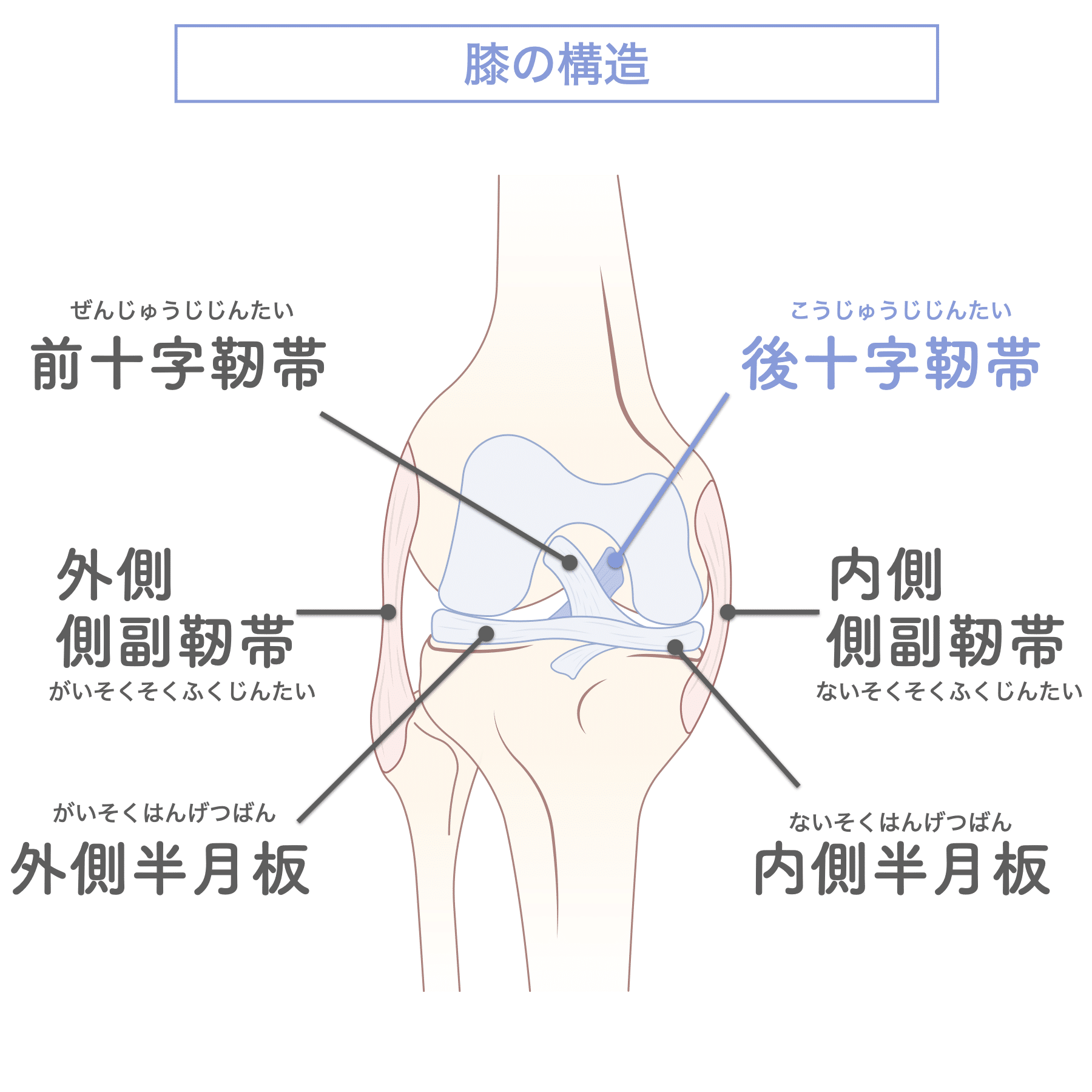
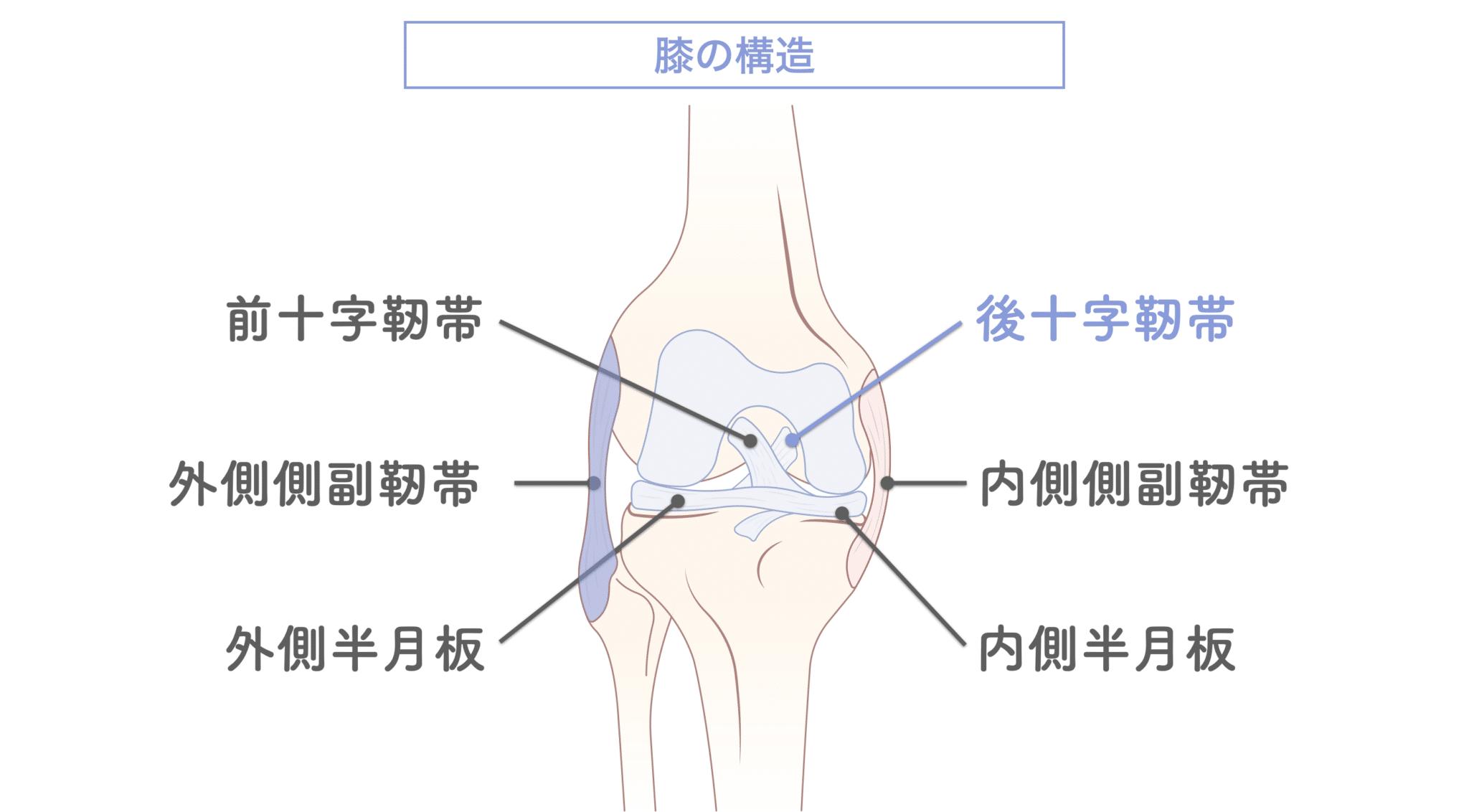
1)骨:膝は大腿骨(大腿骨)、脛骨(脛骨)、腓骨(腓骨)の3つの骨で構成されています。大腿骨の上端で脛骨と接続し、下端で脛骨と腓骨と接続します。
2)靭帯:膝の周囲には、靭帯と呼ばれる組織があります。靭帯は関節を安定させ、サポートします。最も重要な靭帯には、前十字靭帯(ACL)、後十字靭帯(PCL)、内側側副靭帯(MCL)、外側側副靭帯(LCL)があります。
3)軟骨:膝関節には、軟骨と呼ばれる滑らかで弾力性のある組織があります。軟骨は骨同士が摩擦するのを防ぎ、関節のスムーズな動きを可能にします。
4)坐骨筋:膝の後ろにある坐骨筋は、関節の安定性を提供し、膝の伸展を助けます。
ここは専門家以外は知らなくても良い部分です。ざっくりと、「4つの靭帯の構造がうまく連携して働くことで、膝関節は正常に機能し、体重を支え、歩行や走行などの動作を行うことができる」とだけ思い浮かべば良いと思います。
後十字靭帯損傷とは?
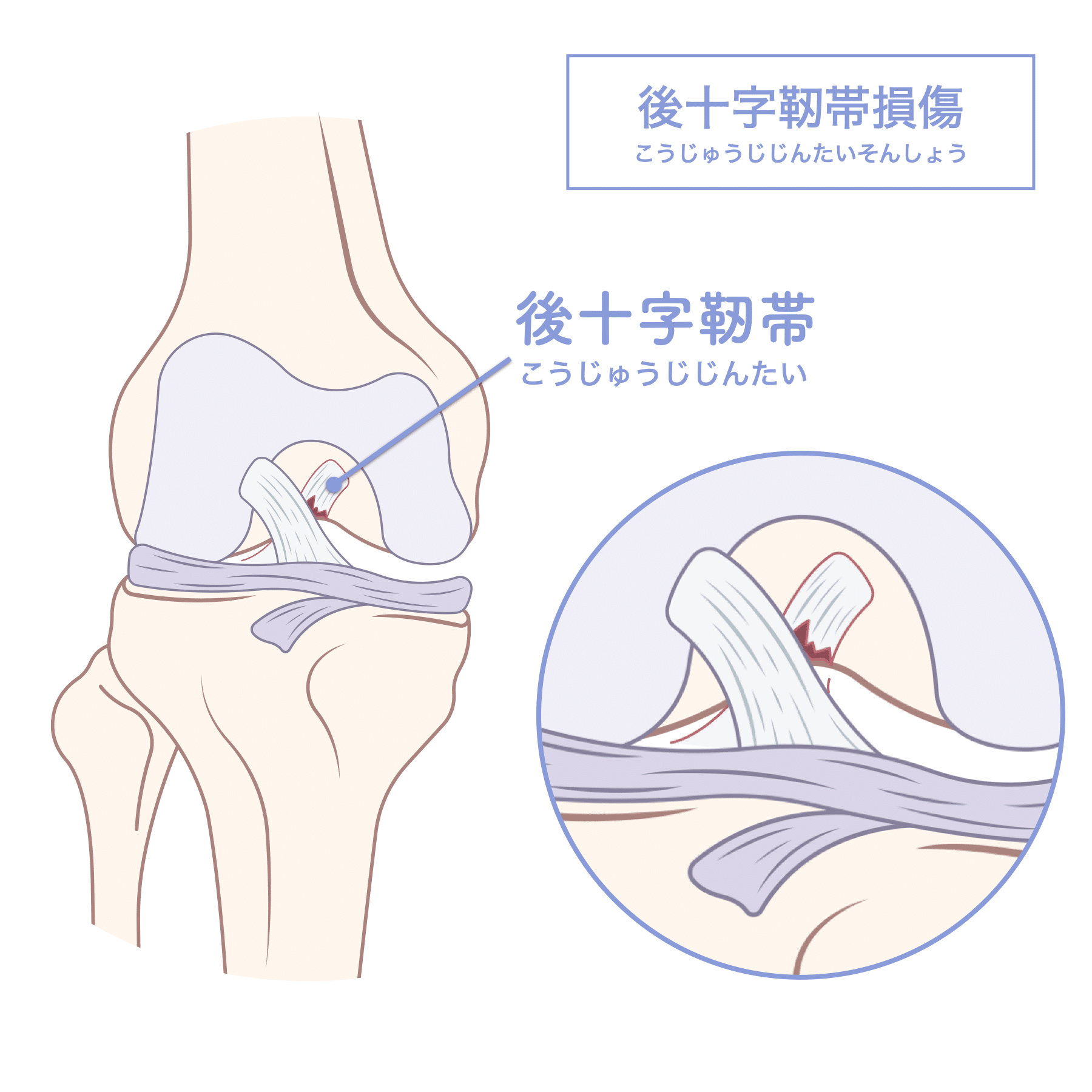

後十字靭帯損傷(PCL損傷)とは、膝の後十字靭帯が部分的または完全に損傷した状態を指します。後十字靭帯は膝の安定性を保つ重要な靭帯の1つであり、スポーツや突然の動作による怪我などが原因で損傷することがあります。PCL損傷は膝の不安定感や腫れ、痛みなどの症状を引き起こすことがあり、適切な治療が必要です。
後十字靭帯損傷(PCL損傷)は、スポーツや急激な動きによる捻挫などが原因となることが多いのですが、起こしやすい人とそうでない人がいます。その違いは、膝関節のアライメントが正しい位置にあるかどうかなのです。そのため、スポーツなどで後十字靭帯を損傷しにくくするカラダ作りのためにも、この記事を読んでいただければ幸いです。
膝関節の形が変だと「後十字靭帯」を痛めやすいですよ、ということです。
症状
後十字靭帯損傷(PCL損傷)の症状には、以下のようなものがあります。
1)膝の不安定感やぐらつき感
2)膝の腫れや炎症
3)膝の痛みや圧痛
4)腫れた膝に対する熱感
5)腫れた膝に対する触れると痛みを感じる
6)膝の可動域の制限
7)膝の腫れによる運動制限
8)膝の重み感や不快感
9)膝を曲げた際にクリック音が聞こえる
10)膝を曲げた際に感じる違和感や不調
これらの症状がある場合は、早めに適切な足指の治療を受けることが重要です。この症状は変形性膝関節症や側副靭帯損傷などと似ていますが、結果としてやることは同じなので、それほど気にしなくても良いと思います。医師や理学療法士など専門職の人であれば、MRIやCTなどがなくても触診でほとんどの病態は知ることができるので、テスト方法で見分ける方法を知っておいた方が良いです。
膝に痛みは出るけど、膝が原因ではないよ、ということです。
原因・発症のメカニズム
後十字靭帯損傷(PCL損傷)の発生要因
後十字靭帯損傷(PCL損傷)の発生要因としては、一般的な医学では以下のようなものが挙げられます。
1)スポーツ活動: バスケットボール、サッカー、フットボールなどの運動競技やスキーやスノーボードなどの冬季スポーツでは、急激な動きや着地、突然の方向転換などがPCL損傷のリスクを高めます。
2)外傷: 交通事故や転倒、異常な角度での膝関節への負荷など外部からの衝撃や負担が加わることで、PCLが損傷することがあります。
3)膝関節の不安定性: 膝関節の構造や筋力のバランスが崩れていると、PCLに過度の負荷がかかり損傷するリスクが高まります。
4)過去の膝の怪我: 以前に膝の怪我を経験していると、再発や新たな損傷を起こす可能性が高くなります。
5)筋力不足: 膝関節をサポートする筋力が不足していると、PCLに負担がかかりやすくなります。
6)過度な運動: 過度な運動や不適切なトレーニングが膝に負担をかけ、PCL損傷を引き起こすことがあります。
突発的な外力による損傷以外では、3)〜6)が発生要因となります。同じ運動(スポーツなど)をしていても、損傷しやすい人とそうでない人がいます。そこには何の違いがあるのかを考えてみることが大切です。
靭帯を痛めやすい人は、脚の形を疑った方が良い、ということです。
後十字靭帯損傷(PCL損傷)の発生要因の力学的なメカニズム
正しい姿勢での後十字靭帯
基本的に人間も含め動物というのは、どのような動きでも対応できる体づくりをしています。そのため、スポーツで怪我をして復帰できない方というのは、筋力不足や過度な運動が「原因」ではなく、怪我をしにくい・怪我をしても回復しやすいカラダの造りをしていないと考える方が合点がいくかともいます。ますはニュートラルポジションという身体の「基本」について知ることから始めましょう。
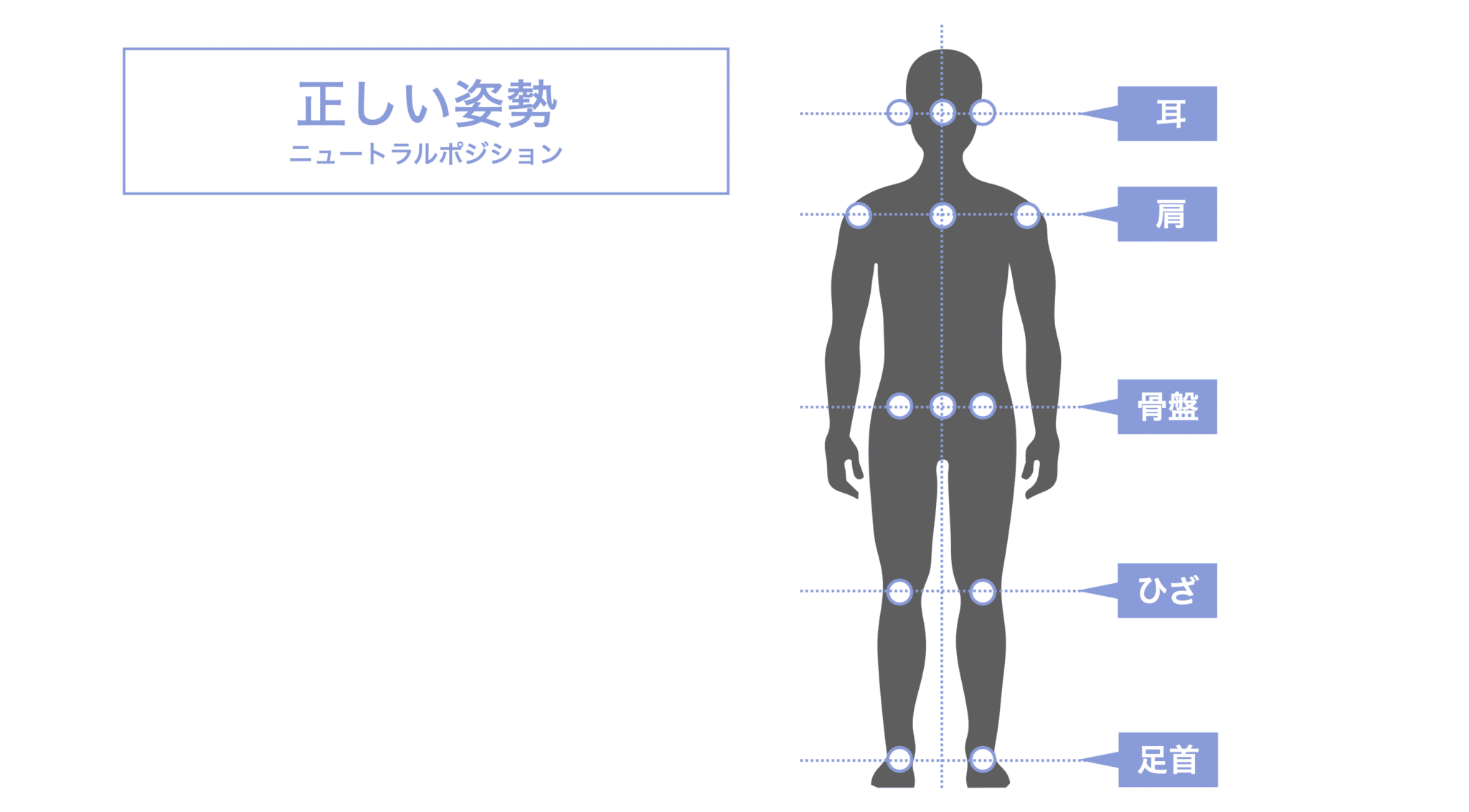
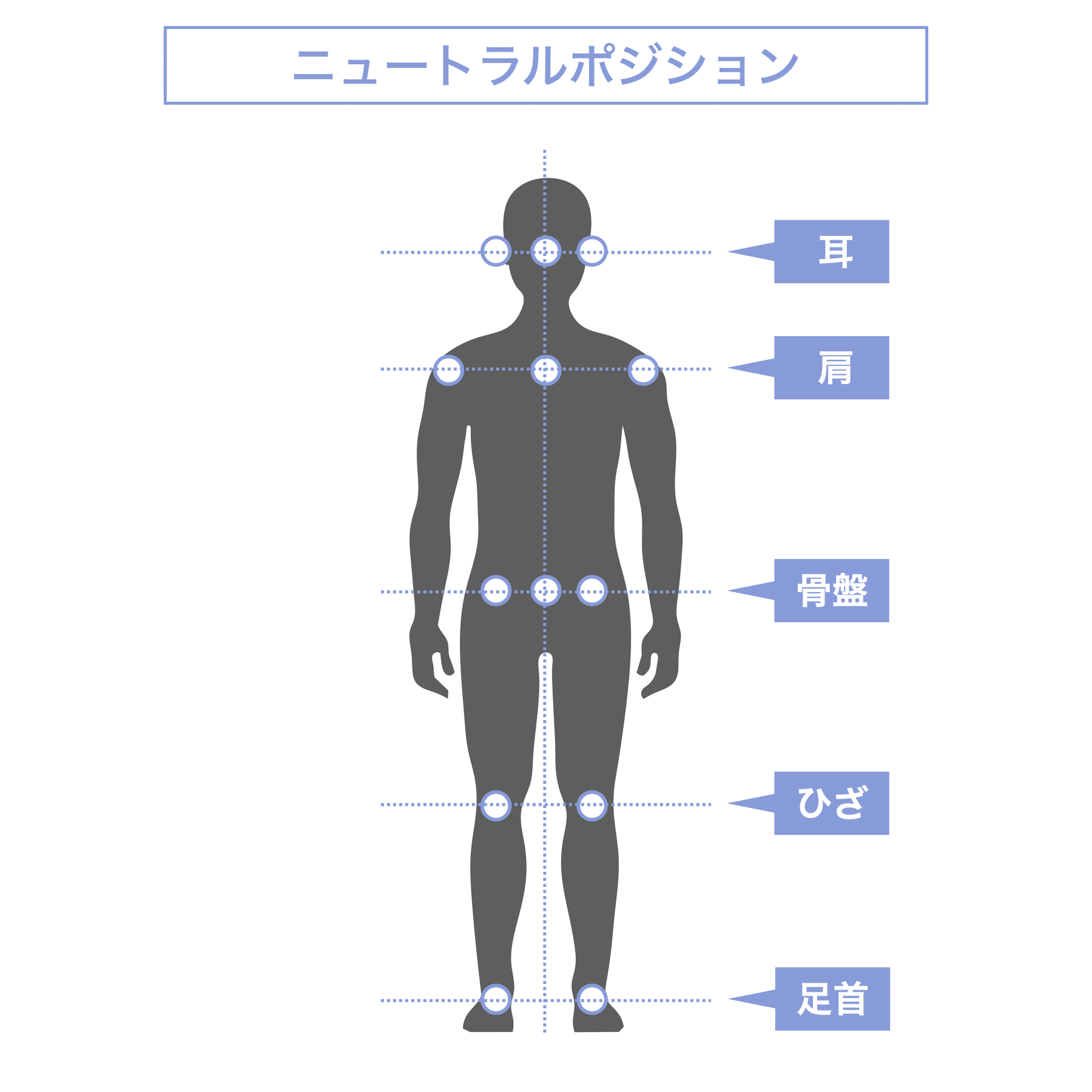
ニュートラルポジションは、正しい姿勢を維持するための基本的な姿勢のことです。この姿勢は、身体の各部位が正しい位置に保たれ、体重が均等に分散されている状態を指します。身体 ( 関節、筋肉、靭帯 ) への負担が最小限で全身の運動機能や循環機能の働きがバランス良く円滑に発揮し易い状態になります。詳細にはいろいろありますが、ここでは骨盤から下の部分だけをみていきましょう。
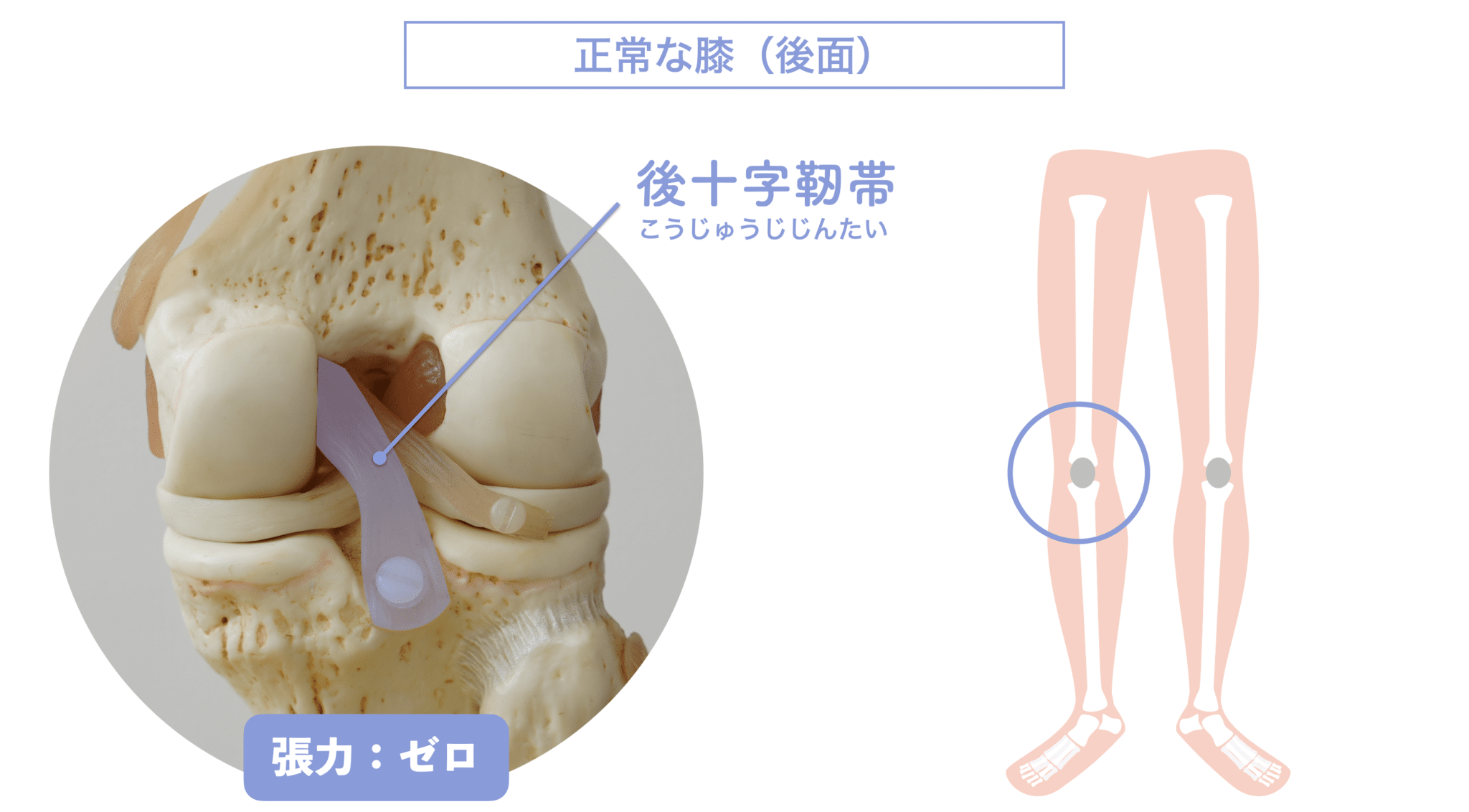
ニュートラルポジションの状態であれば、膝関節のアライメント(膝の正しい位置や角度)はまっすぐなので、後十字靭帯には負荷(張力)がかかりません。まっすぐ立っている時の張力を0とするならば、膝(大腿骨と下腿骨)を逆方向にねじったとしても、その張力は3(小)程度です。
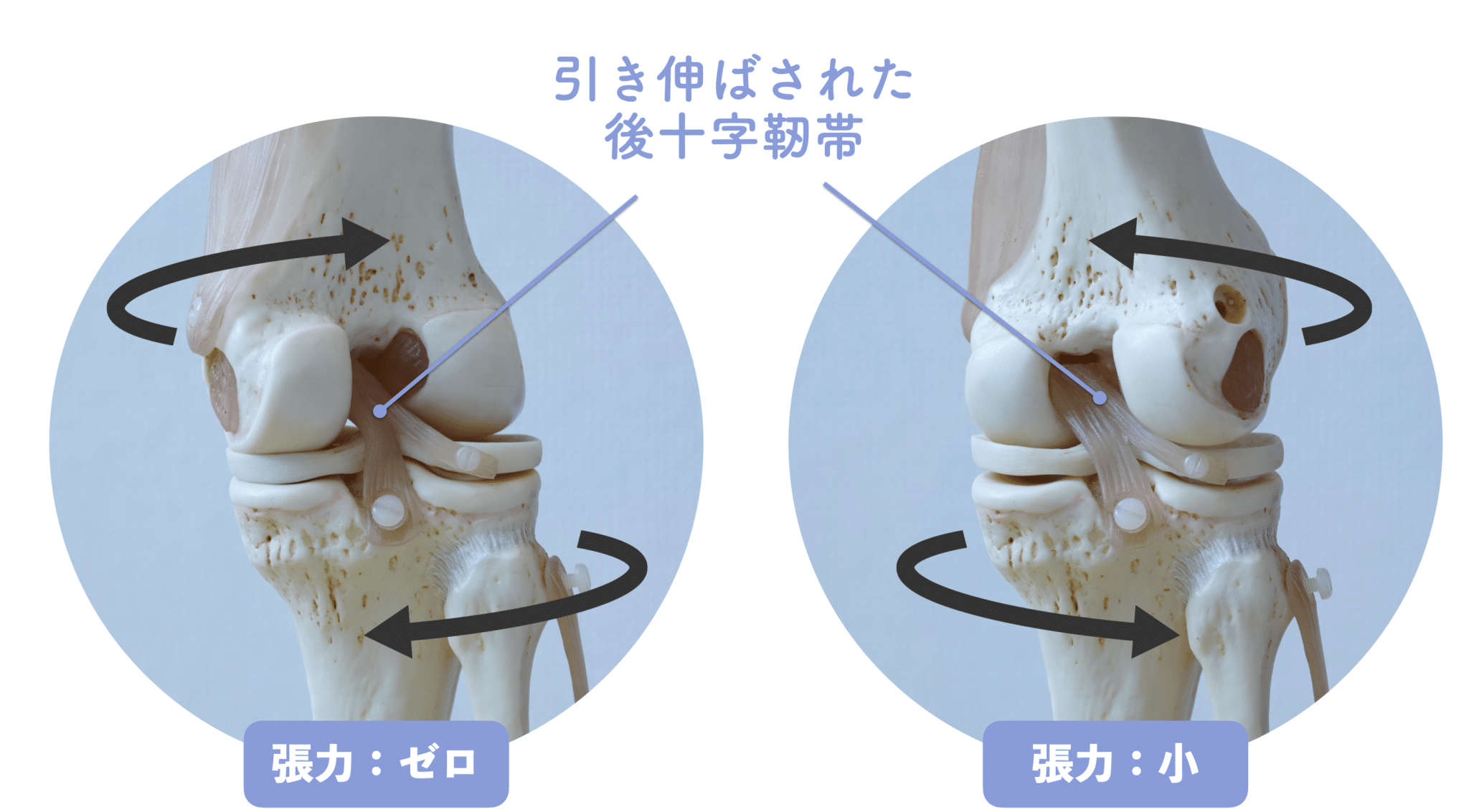
ここでは靭帯の張力について、1〜3を小、4〜6を中、7〜10を大として表現しています。
つまり、膝関節がニュートラルポジションに近ければ近いほど、スポーツや方向転換時において急激な動きが生じても、後十字靭帯にはそれほど影響はしないということなのです。
靭帯はある程度の動きや衝撃にも柔軟に耐えられるようにできている、ということです。
O脚での後十字靭帯
それではO脚の場合はどうなるでしょうか。O脚になると、膝が外側に大きく捻じれることで後十字靭帯が過度に伸ばされていきます。
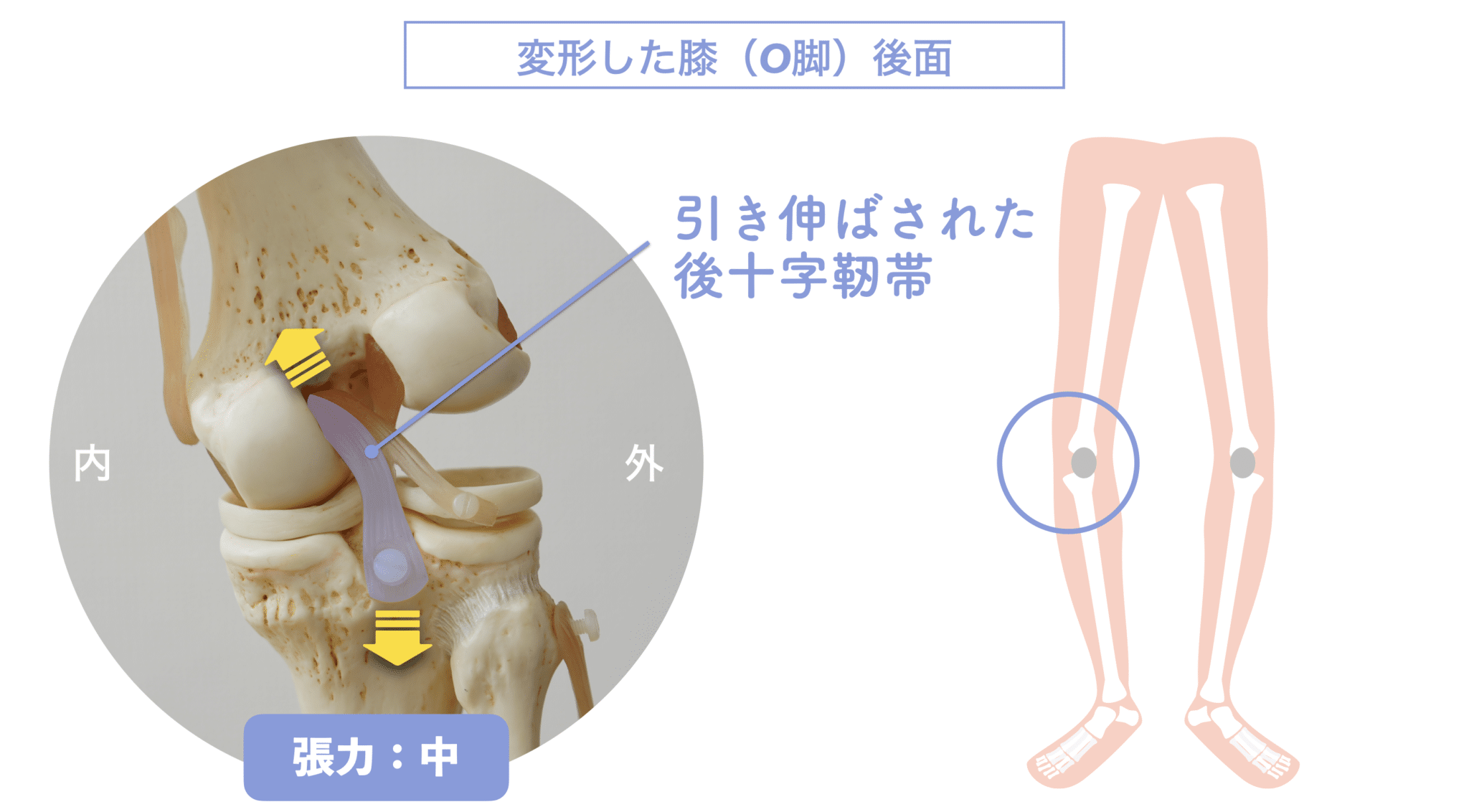
この時の張力は「中」くらいです。しかしO脚は「外股」とセットになるので、下腿を外旋させると後十字靭帯の張力は「小」になります。中から小になるのは、下腿が外旋することで靭帯の停止部分が起始部分に近づくからです。
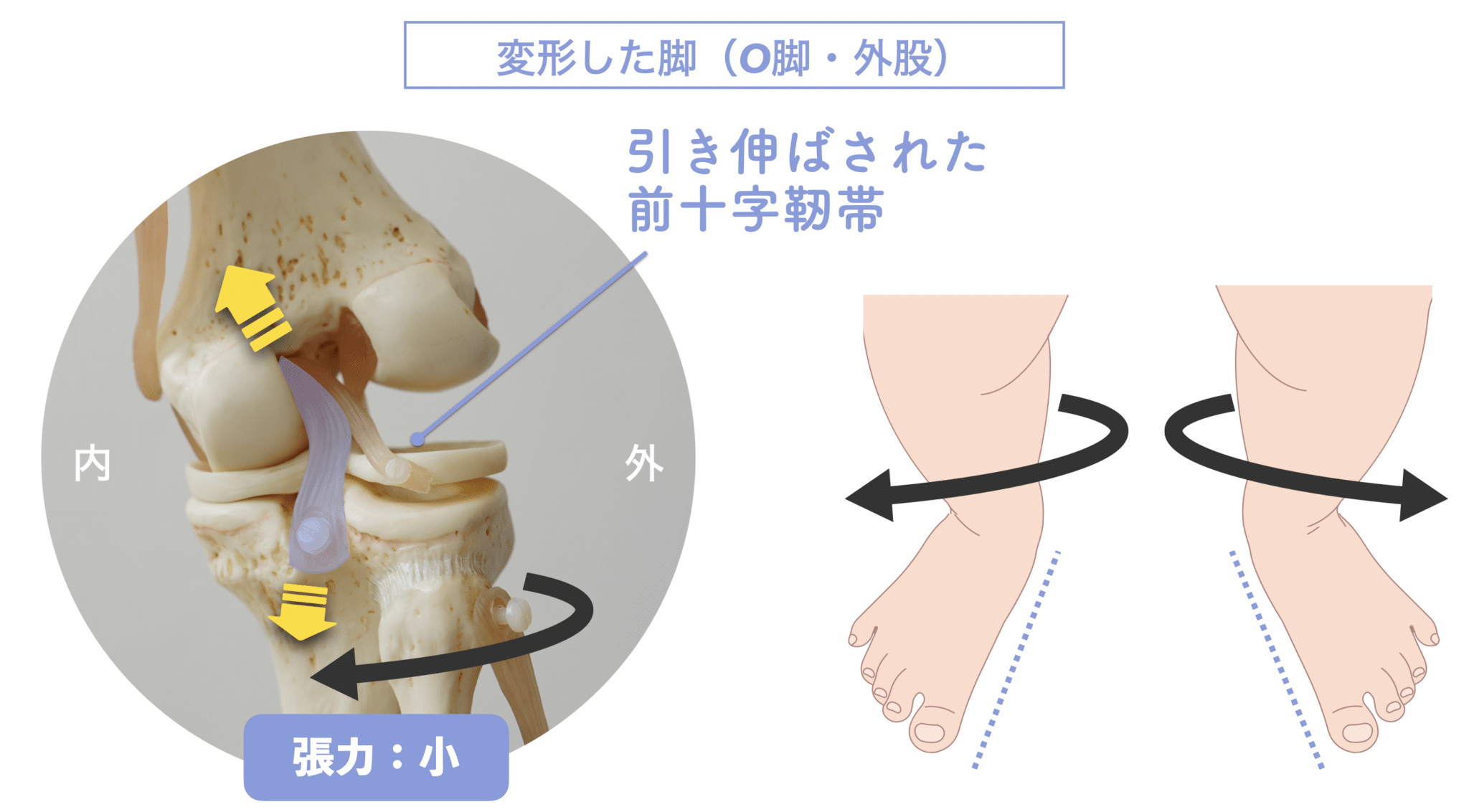
ニュートラルポジションの脚に比べると多少は張力が発生していますが、後十字靭帯が損傷を起こすほどではありません。しかしO脚+外股の人が、何かしらの理由(スポーツや方向転換など)で大腿部が内股(下腿がさらに外旋)になったらどうなるでしょうか?

後十字靭帯の張力は最大の「大」となり、損傷を起こしやすい状態となってしまいます。
ニュートラルポジションの脚では、膝がどんなに逆方向に捻れたとしても、後十字靭帯の張力は「小」でした。しかしO脚で外股の人だと、下腿骨が内旋したとたんに張力が「大」になります。
つまり、O脚の人はスポーツでの急激な動きや着地、日常生活での突然の方向転換などで、常に後十字靭帯への負荷が高くなっており、ふとした事で膝下の部分を内側に向けることで、後十字靭帯損傷や断裂を起こしやすい状態になるということなのです。
後十字靭帯損傷を起こさないようにする、再発を繰り返さないようにするためには、O脚をできるだけニュートラルポジションに近づけることが大切だということがわかったでしょうか?O脚の原因や治し方は以下のリンクを参照にしてみてください。
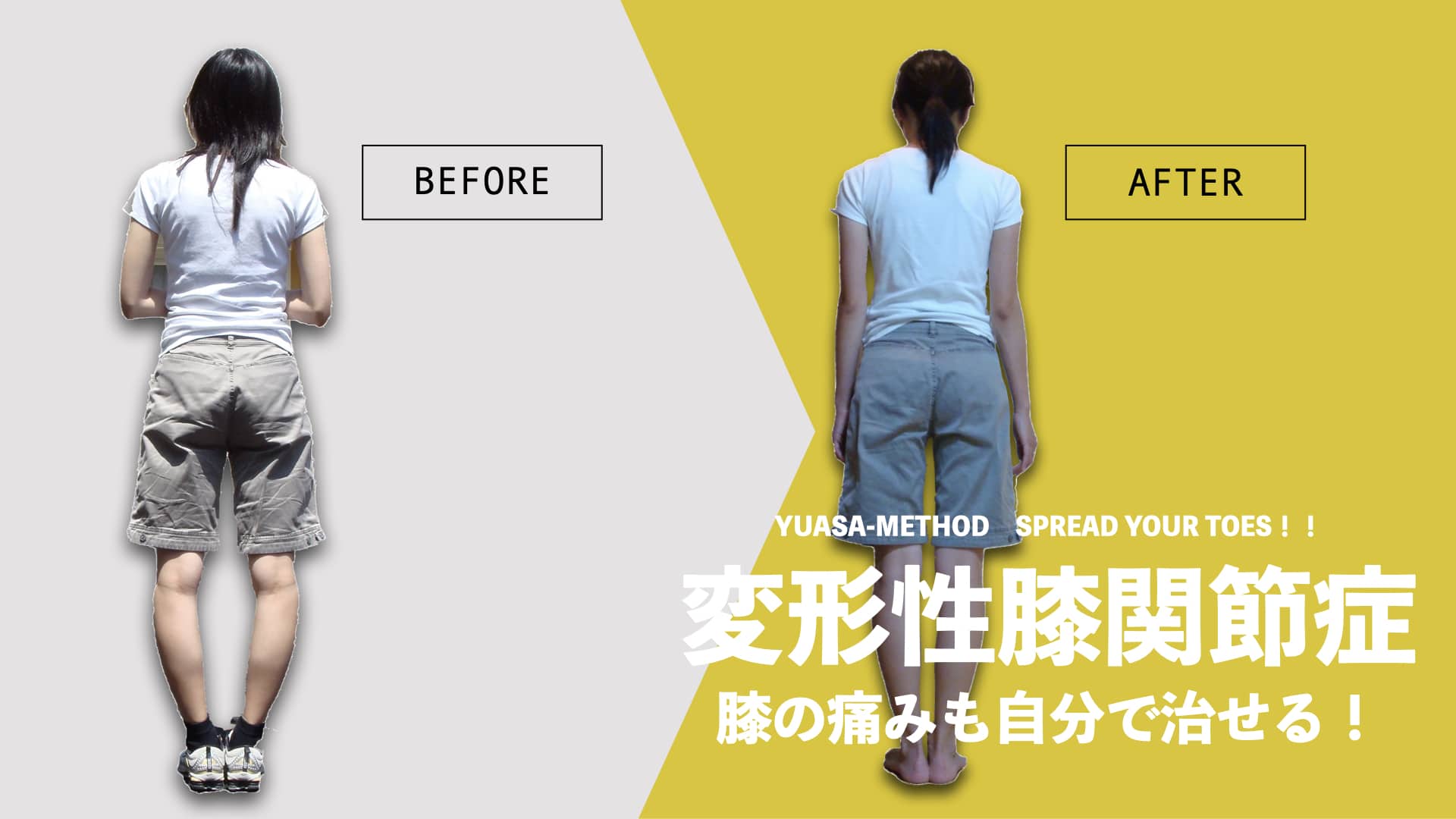
O脚になっている地点で靭帯を痛めやすいカラダになっている、ということです。
後十字靭帯損傷を起こしやすくするO脚の原因とは?
例えば、小指の機能不全もしくは内反小趾があるとします。小指は基本的に「足が外側に倒れないようにするための役割」があります。
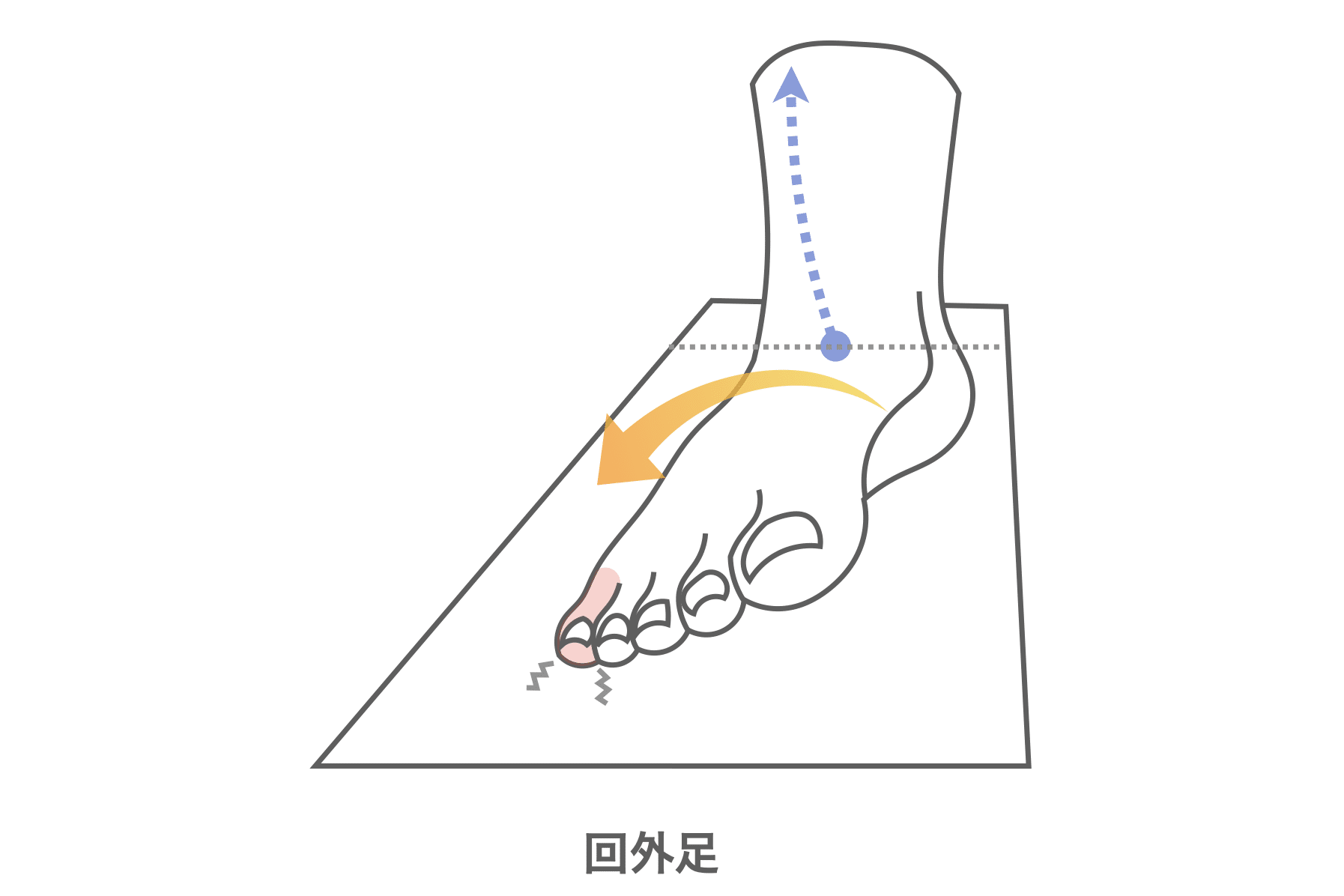
内反小趾や小趾機能不全(小指のパーができないなど)があると、歩く(足を蹴り出す)ときに足が外側に倒れてしまいます。足が外側に倒れることを「回外足」と言います。
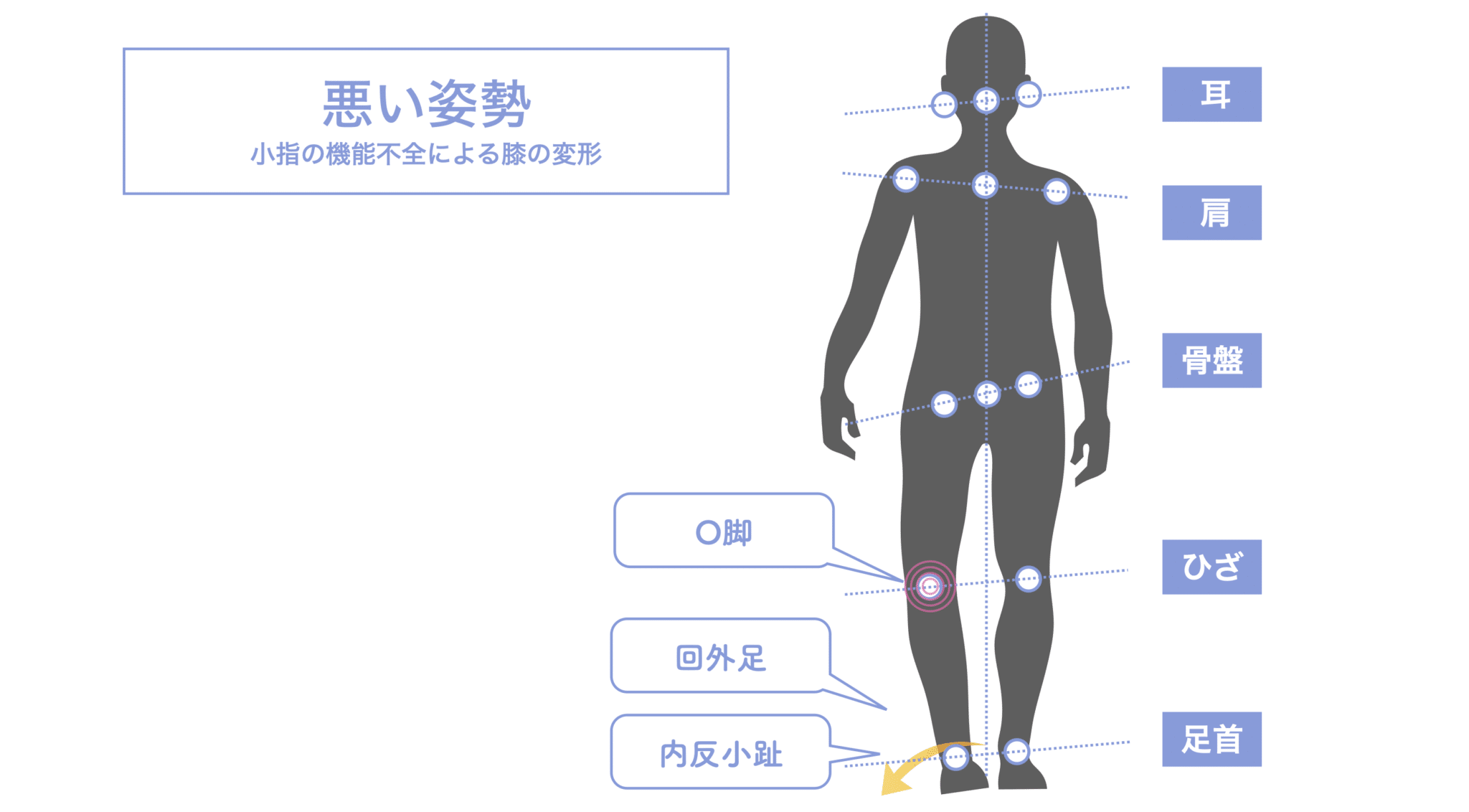
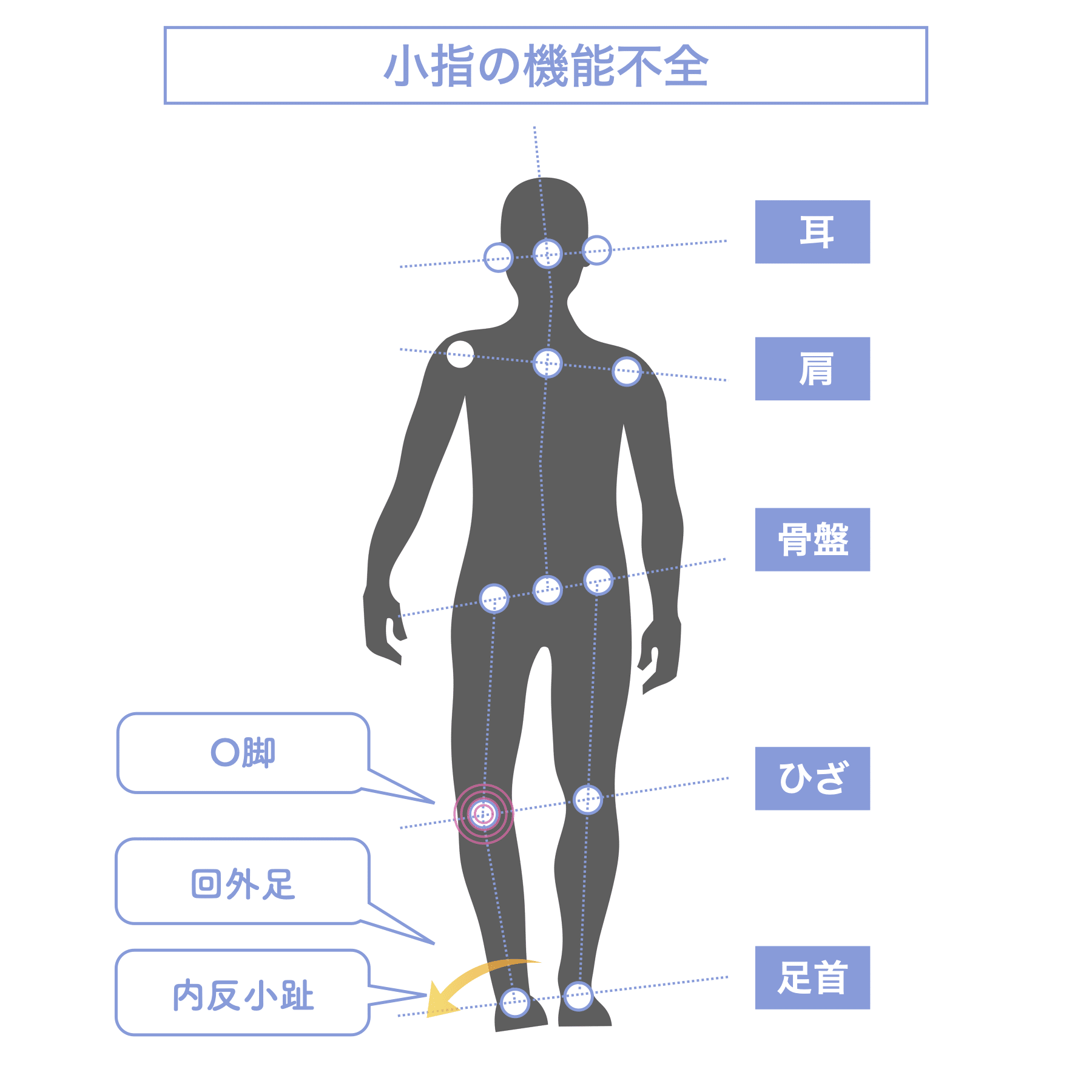
回外足になると、そのまま下腿骨が外側に倒れていくのでO脚という足の変形を起こしていくのです。
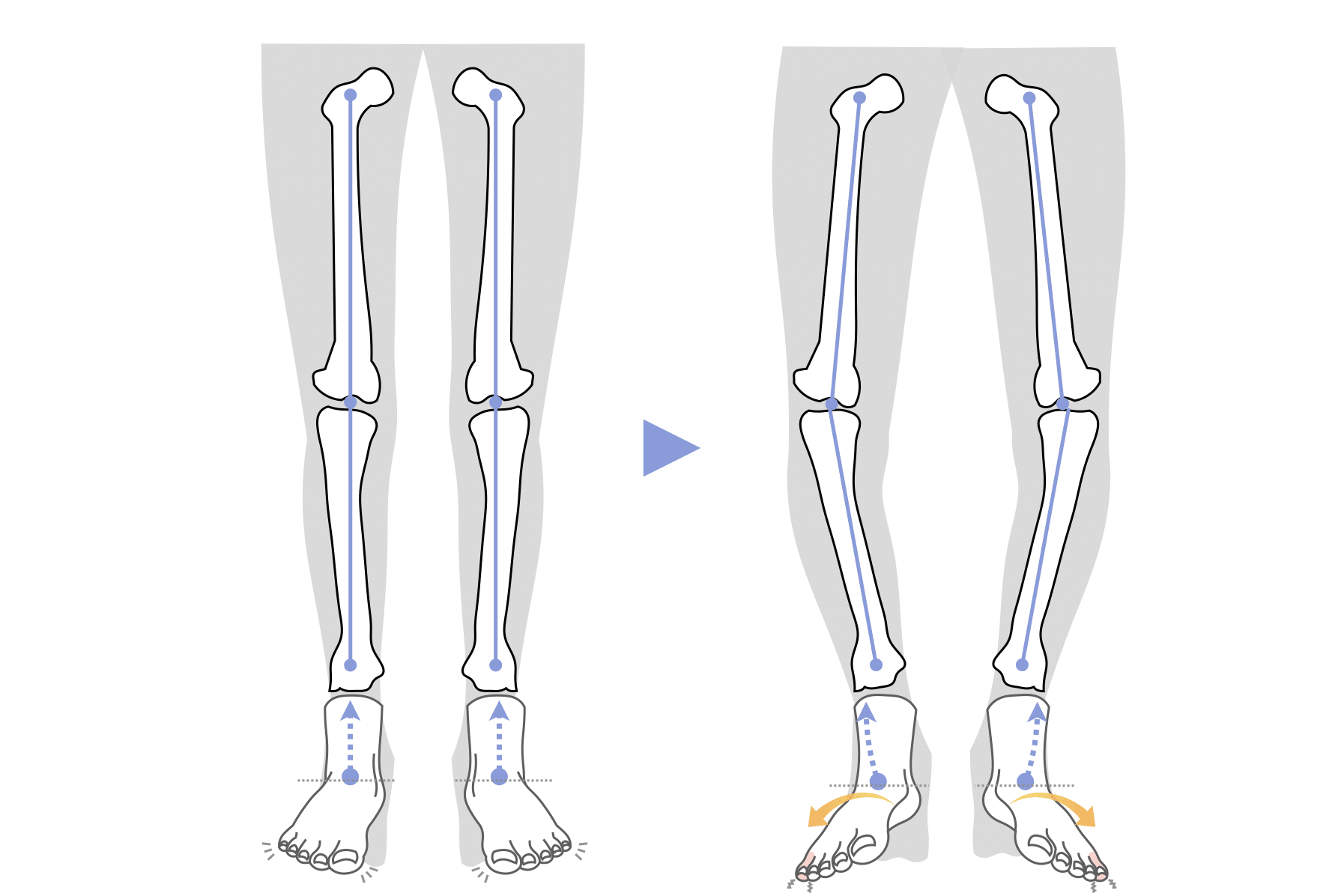
親指と小指が正常に働くことで、人はまっすぐに立って、まっすぐに歩くことができます。つまり、内反小趾や小趾機能不全の状態で歩くことは、O脚になることと直結するのです。
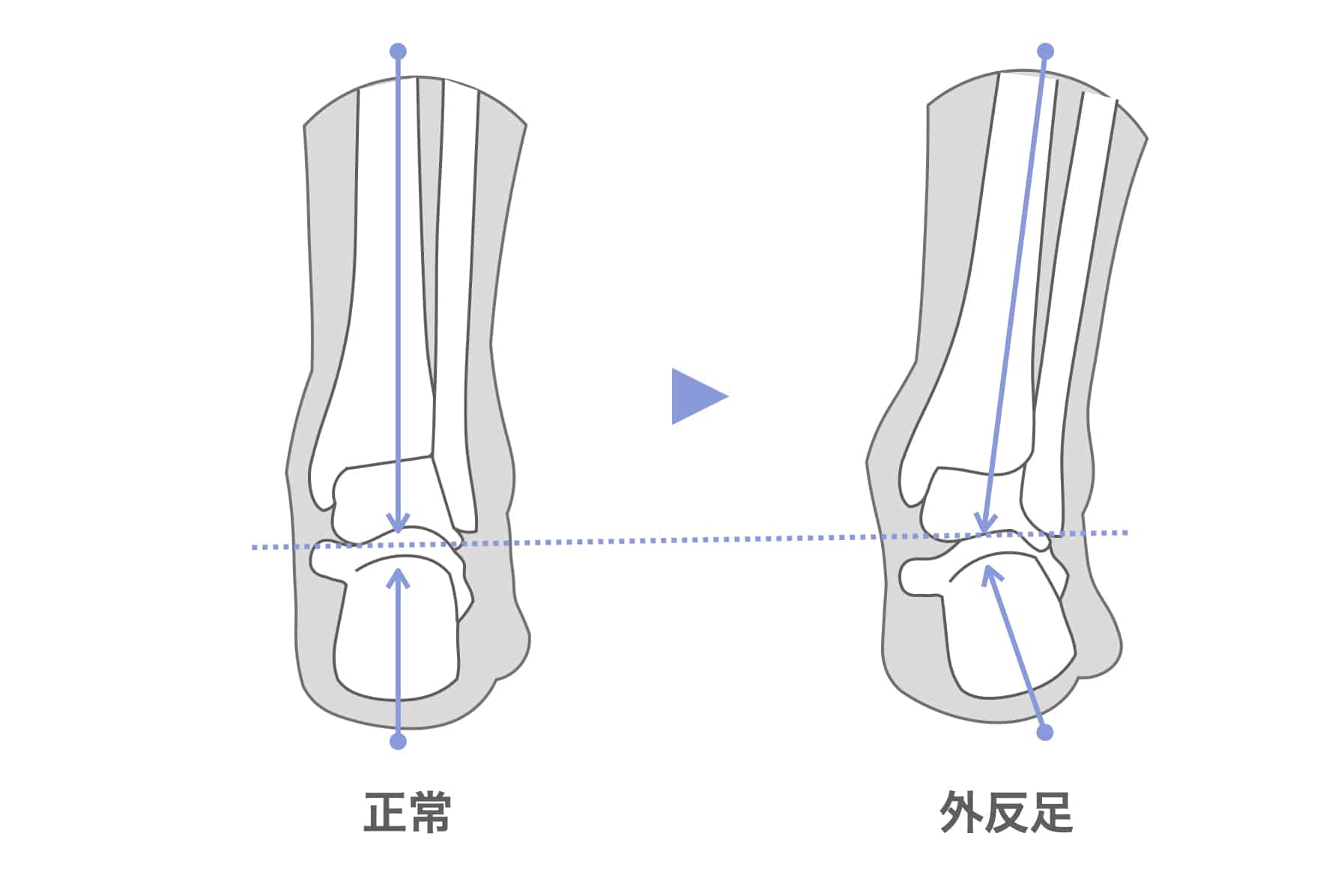
足が外側に倒れる原因として、外反足という変形もあります。これはかがみ指や浮き指によって足裏の筋力が低下し、踵の骨が内側に傾くことをいいます。踵が内側に傾くと、踵の上に位置する下腿骨が外側に倒れてバランスを取ろうとします。そうすることでO脚変形になることもあります。
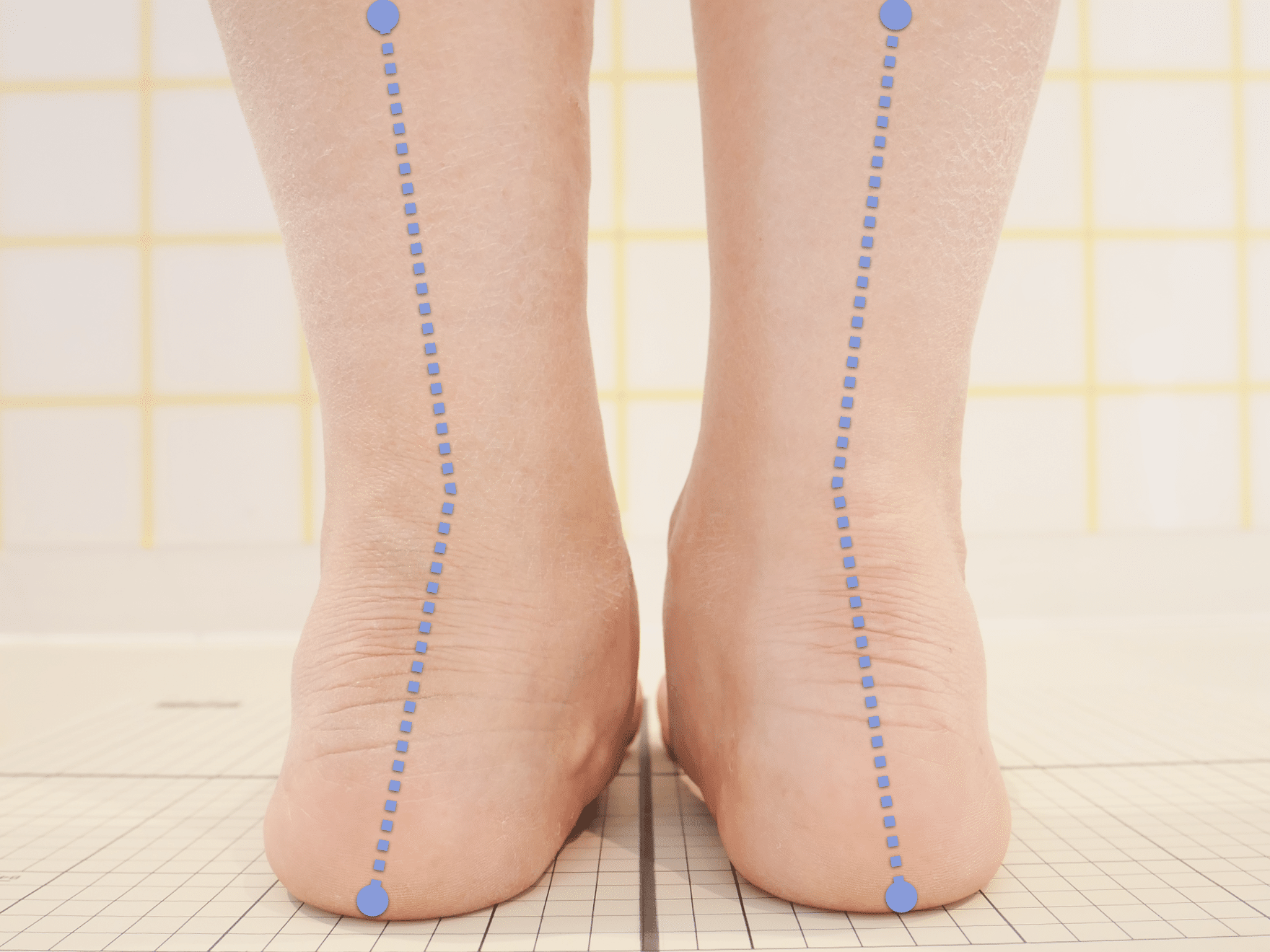
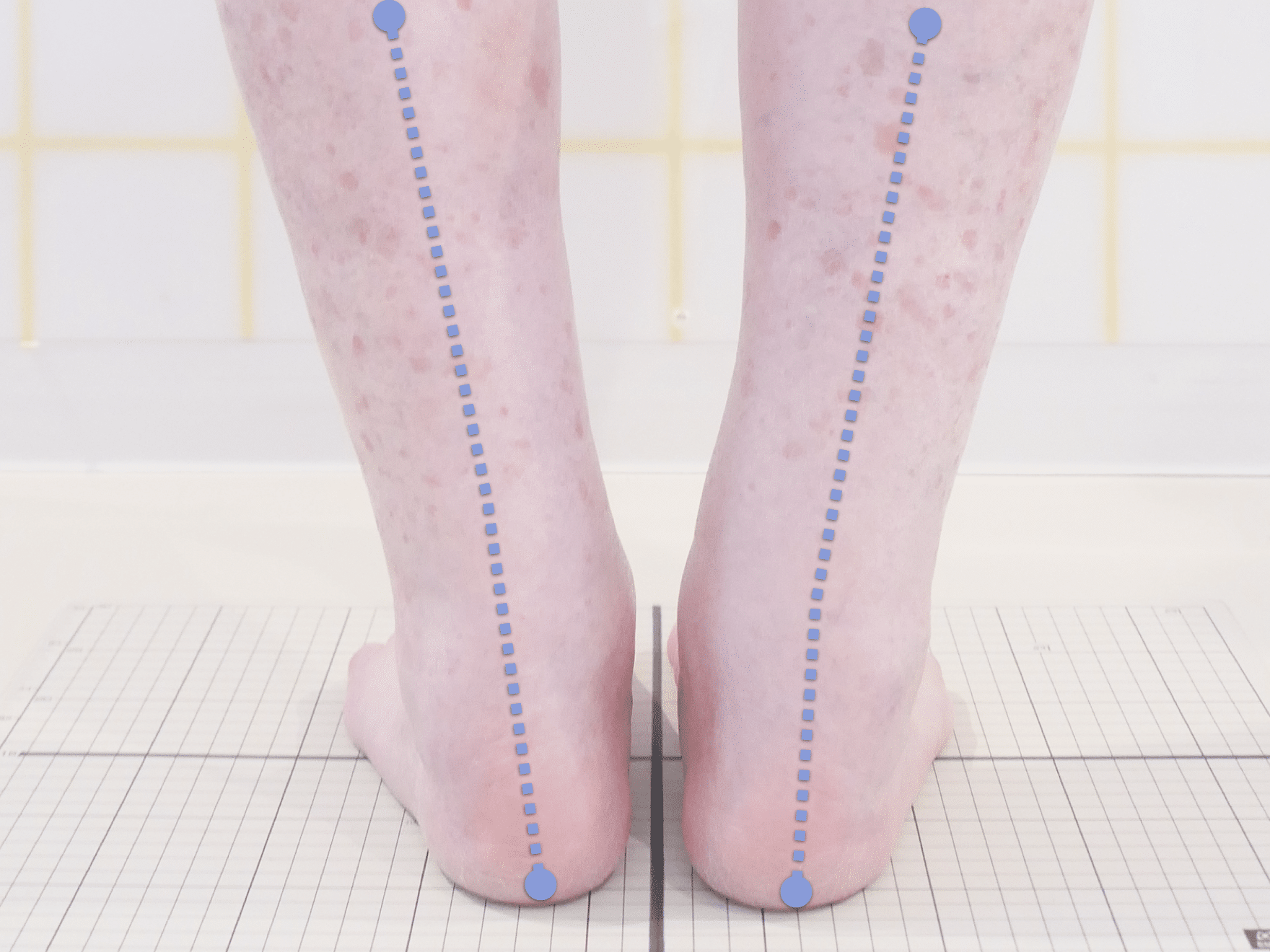
小指が使えないとO脚になる。靭帯の問題だけれども、小指が原因の可能性があるということ。
X脚での後十字靭帯
それではX脚の場合はどうなるでしょうか。X脚になると、膝が内側に大きく捻じれることで後十字靭帯が過度に伸ばされていきます。後十字靭帯の起始部分が大腿骨の外側に位置するので、O脚の場合に比べると、張力はそれほど強くはありません。
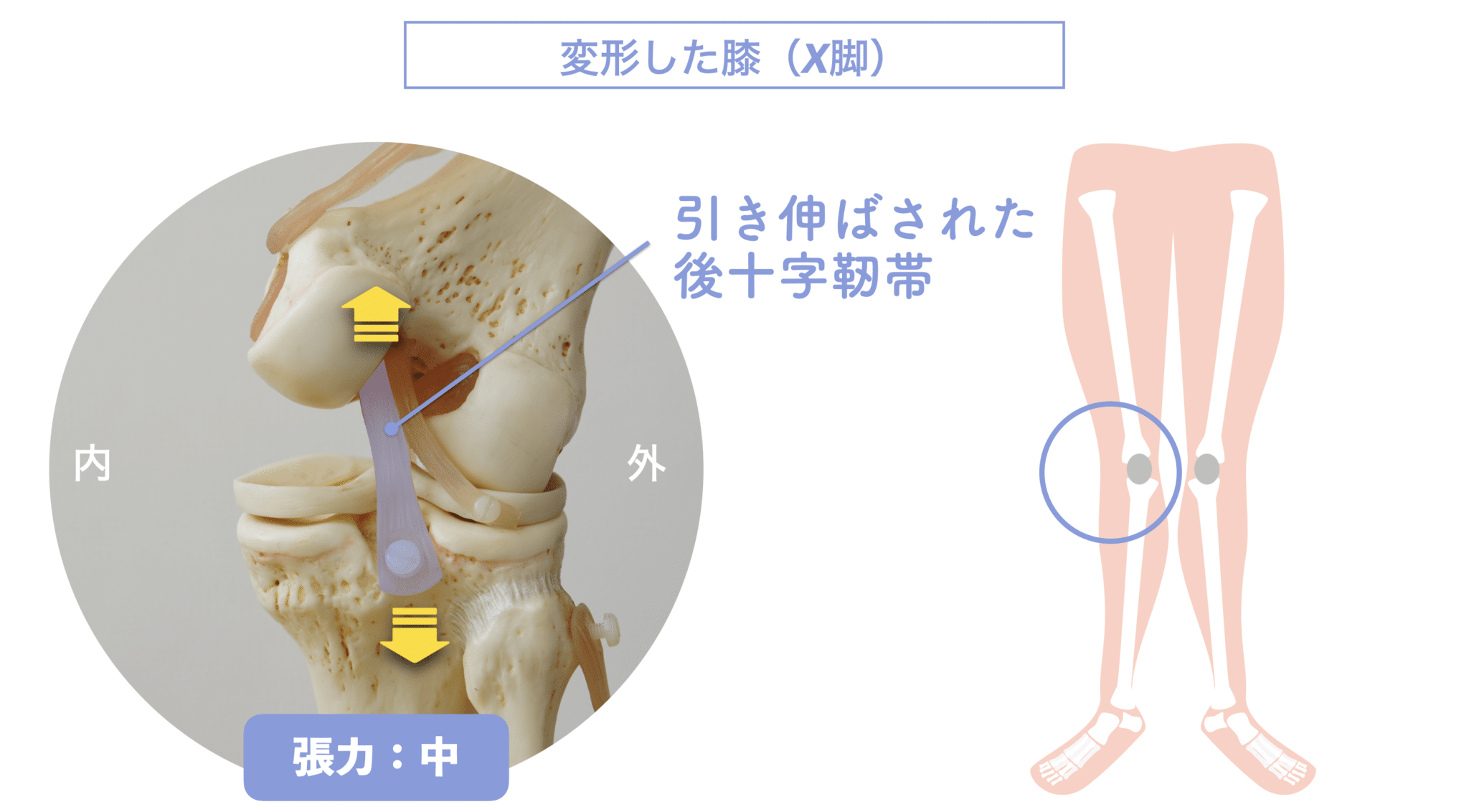
この時の張力は「中」くらいです。しかしX脚は「内股」とセットになるので、下腿を内旋させると後十字靭帯の張力は「小」になります。中から小になるのは、下腿が内旋することで靭帯の停止部分が起始部分に近づくからです。
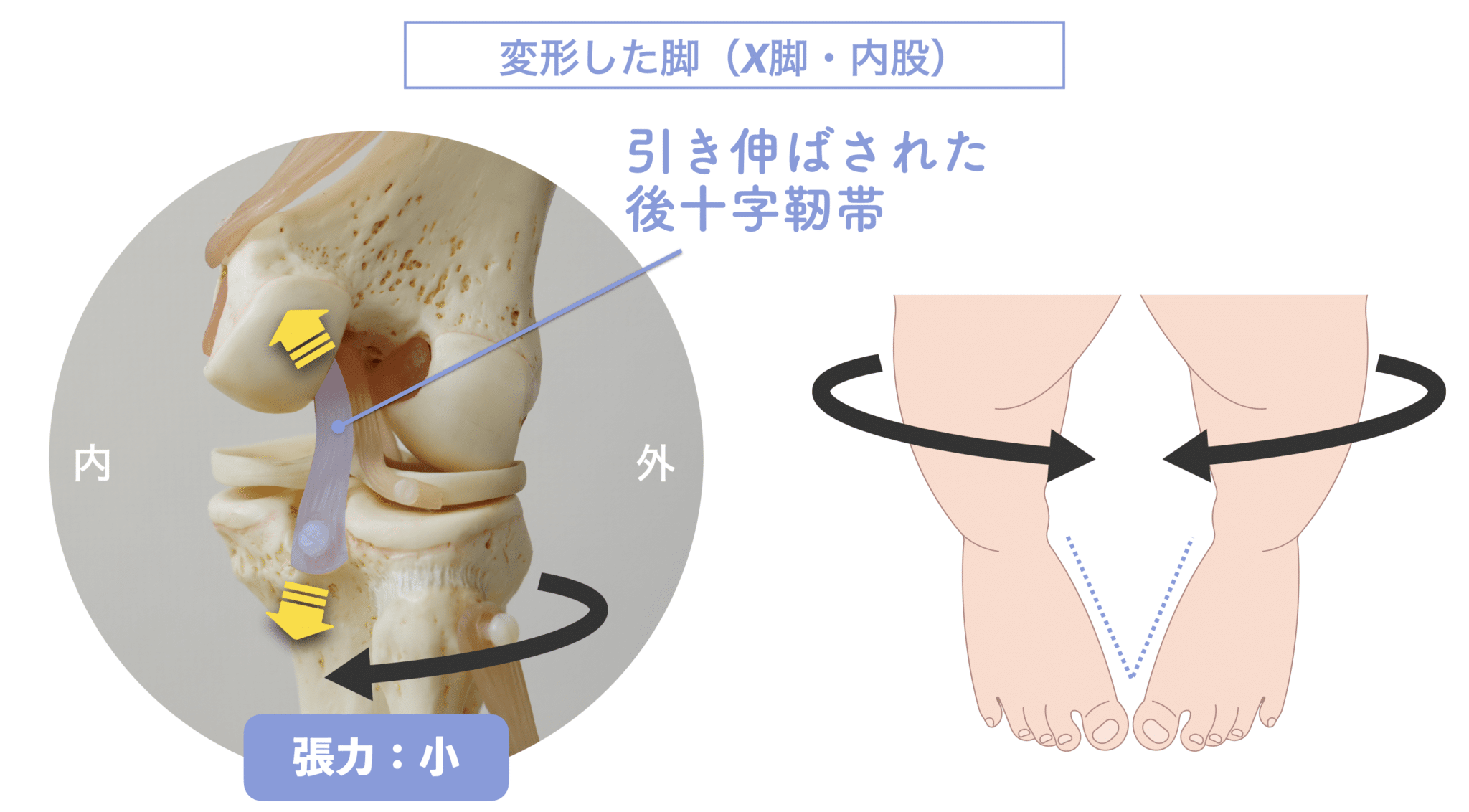
ニュートラルポジションの脚に比べると多少は張力が発生していますが、後十字靭帯が損傷を起こすほどではありません。しかしX脚+内股の人が、何かしらの理由(スポーツや方向転換など)で外股になったらどうなるでしょうか?

後十字靭帯の張力は最大の「大」となり、損傷を起こしてしまいます。
ニュートラルポジションの脚では、膝がどんなに逆方向に捻れたとしても、後十字靭帯の張力は「小」でした。しかしX脚で内股の人だと、下腿骨が外旋したとたんに張力が「大」になります。
つまり、X脚の人はスポーツでの急激な動きや着地、日常生活での突然の方向転換などで、常に後十字靭帯への負荷が高くなっており、損傷や断裂を起こしやすい状態にあるということなのです。
後十字靭帯損傷を起こさないようにする、再発を繰り返さないようにするためには、X脚をできるだけニュートラルポジションに近づけることが大切だということがわかったでしょうか?
X脚になっている地点で靭帯を痛めやすいカラダになっている、ということです。
後十字靭帯損傷を起こしやすくするX脚の原因とは?
例えば、親指の機能不全もしくは外反母趾があるとします。親指は基本的に「足が内側に倒れないようにするための役割」があります。
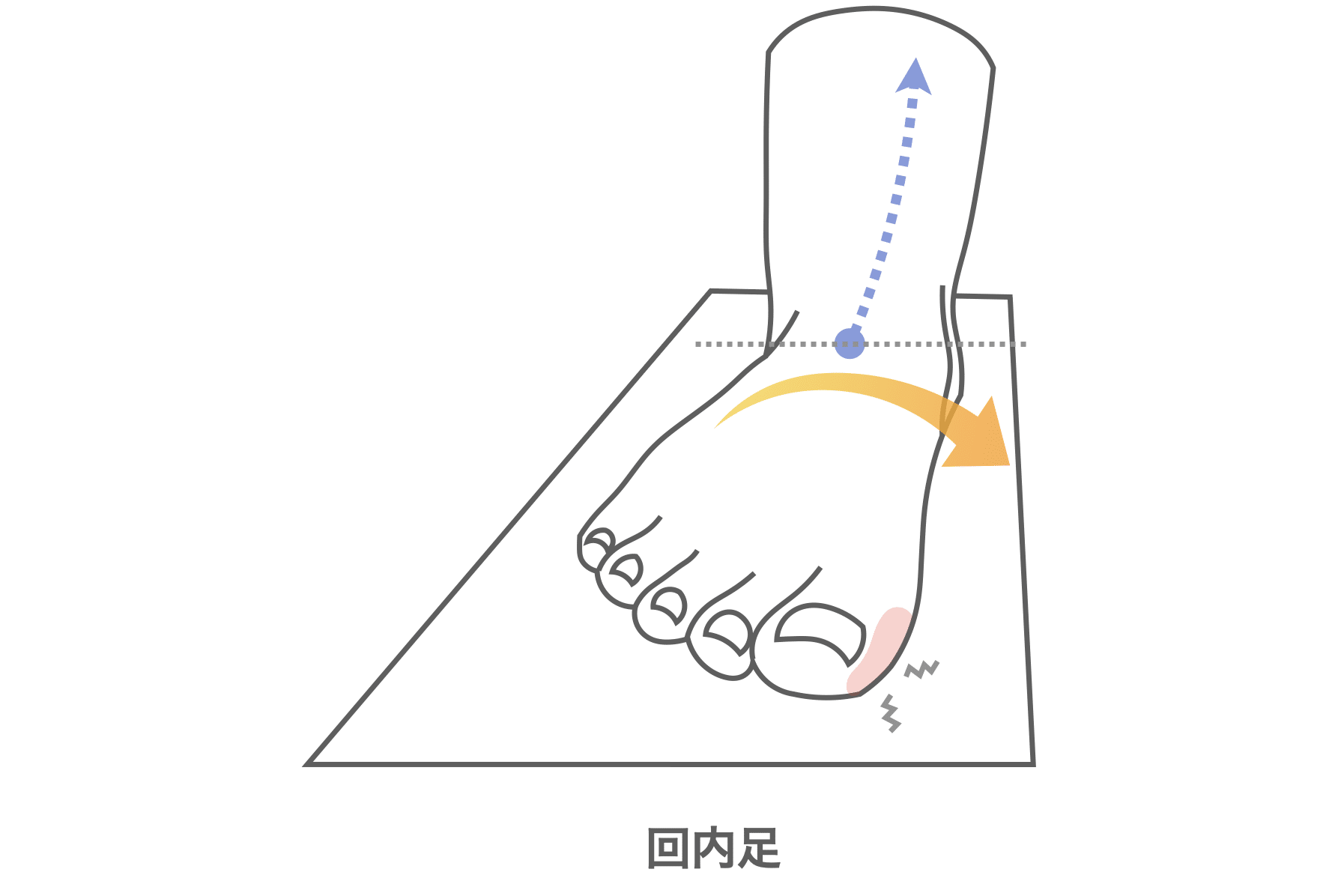
外反母趾や親指機能不全(親指のパーができないなど)があると、歩く(足を蹴り出す)ときに足が内側に倒れてしまいます。足が内側に倒れることを「回内足」と言います。
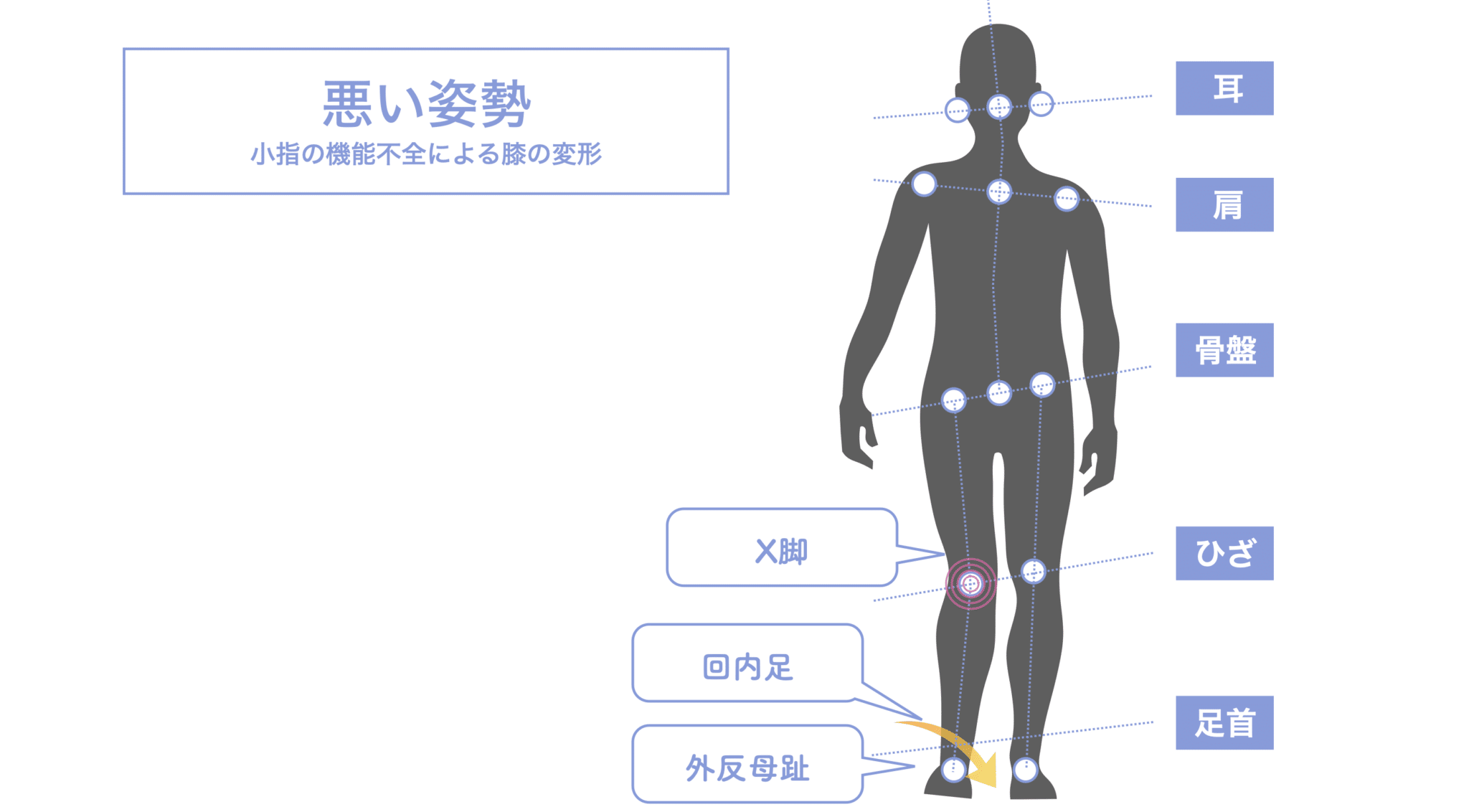
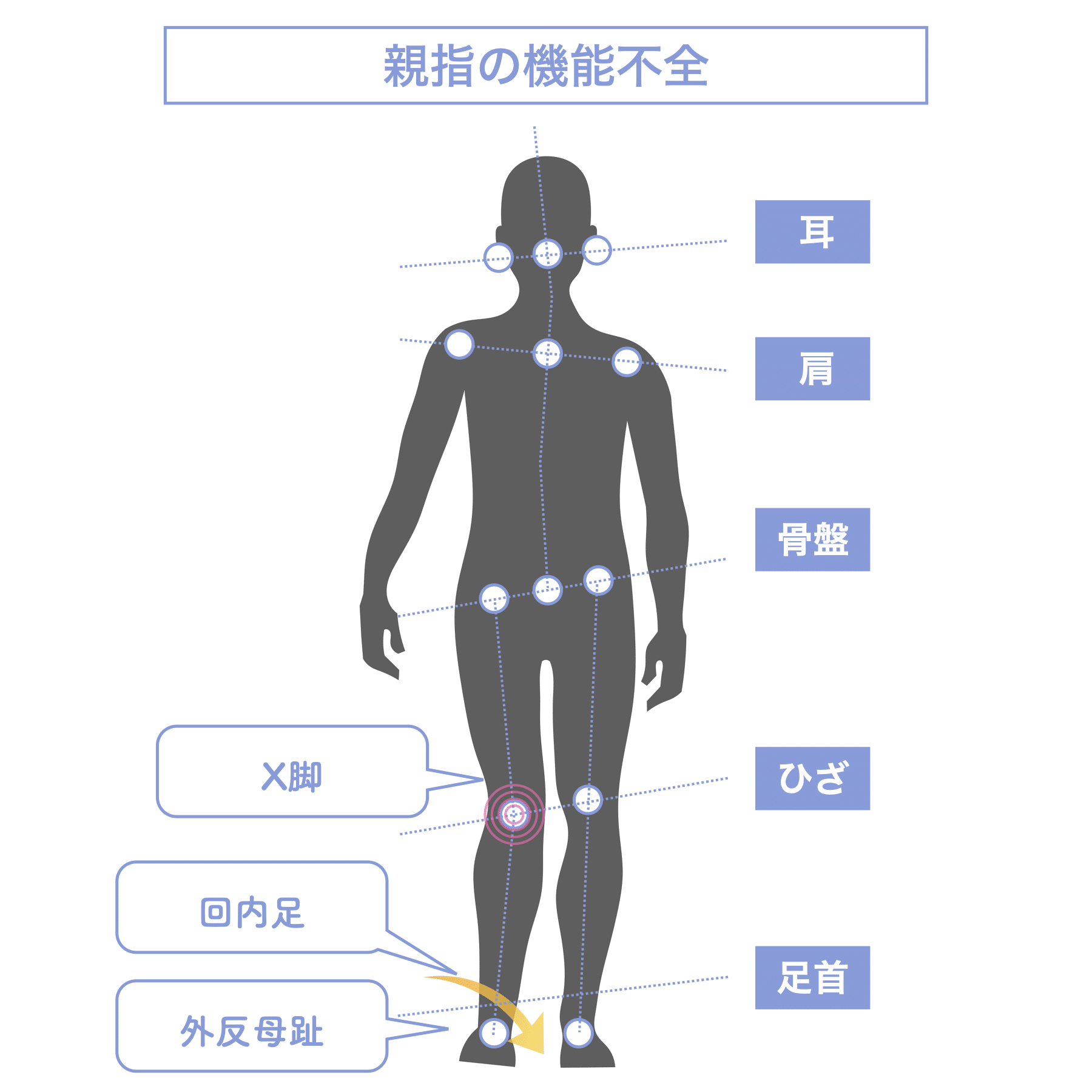
回外足になると、そのまま下腿骨が内側に倒れていくのでX脚という足の変形を起こしていくのです。
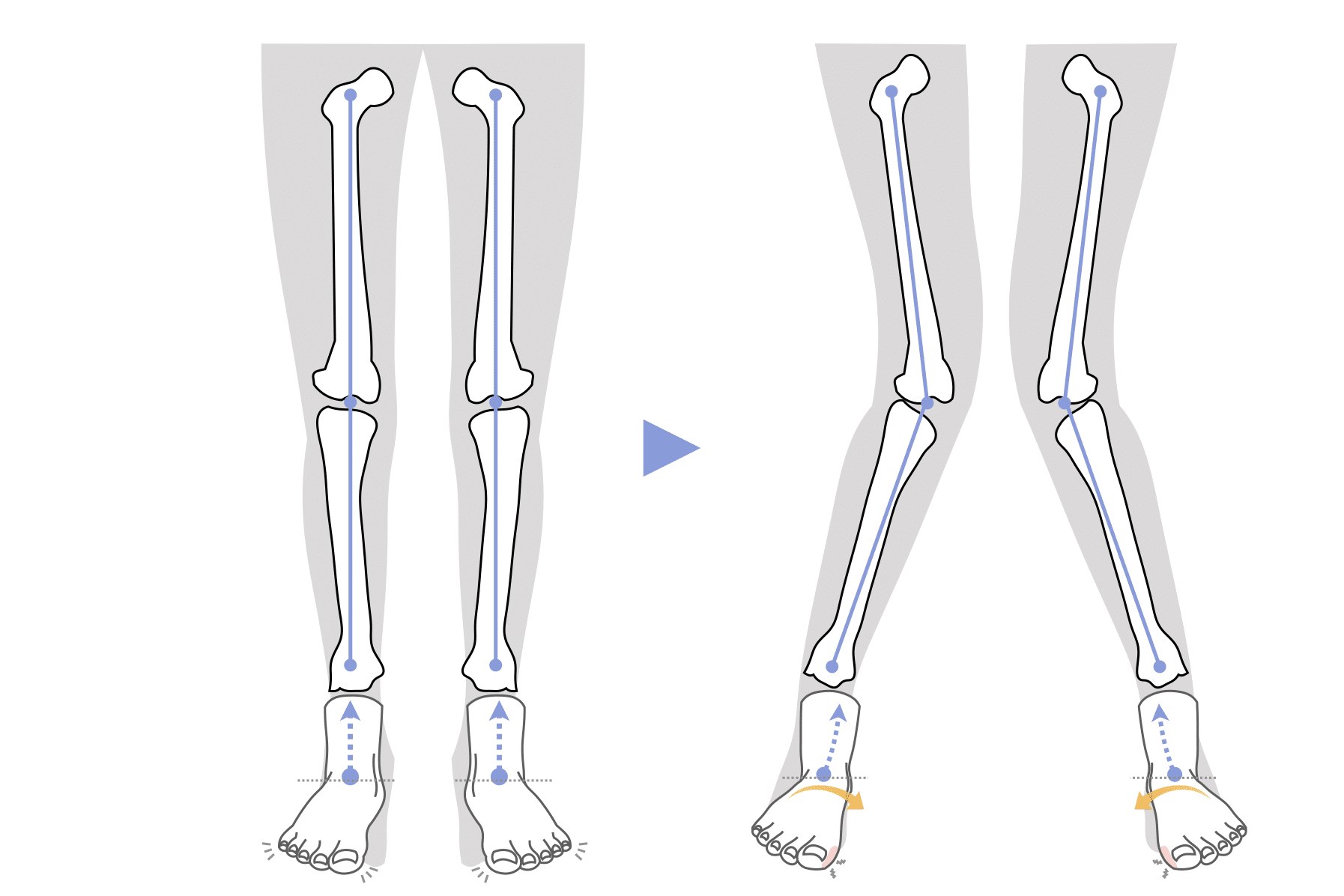
親指と小指が正常に働くことで、人はまっすぐに立って、まっすぐに歩くことができます。つまり、外反母趾や親指機能不全の状態で歩くことは、X脚になることと直結するのです。
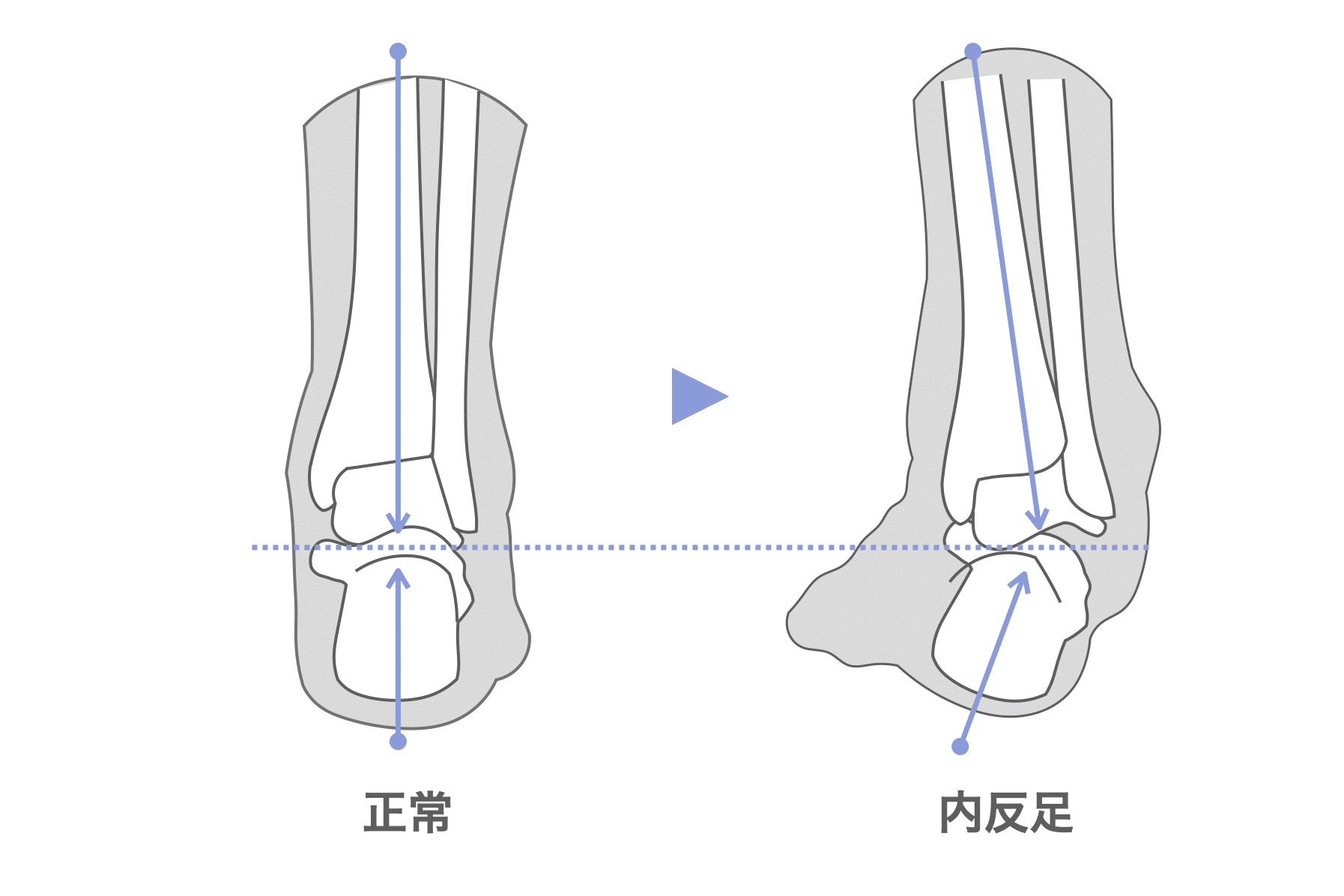
足が内側に倒れる原因として、内反足という変形もあります。これはかがみ指や浮き指によって足裏の筋力が低下し、踵の骨が外側に傾くことをいいます。踵が外側に傾くと、踵の上に位置する下腿骨が内側に倒れてバランスを取ろうとします。そうすることでX脚変形になることもあります。
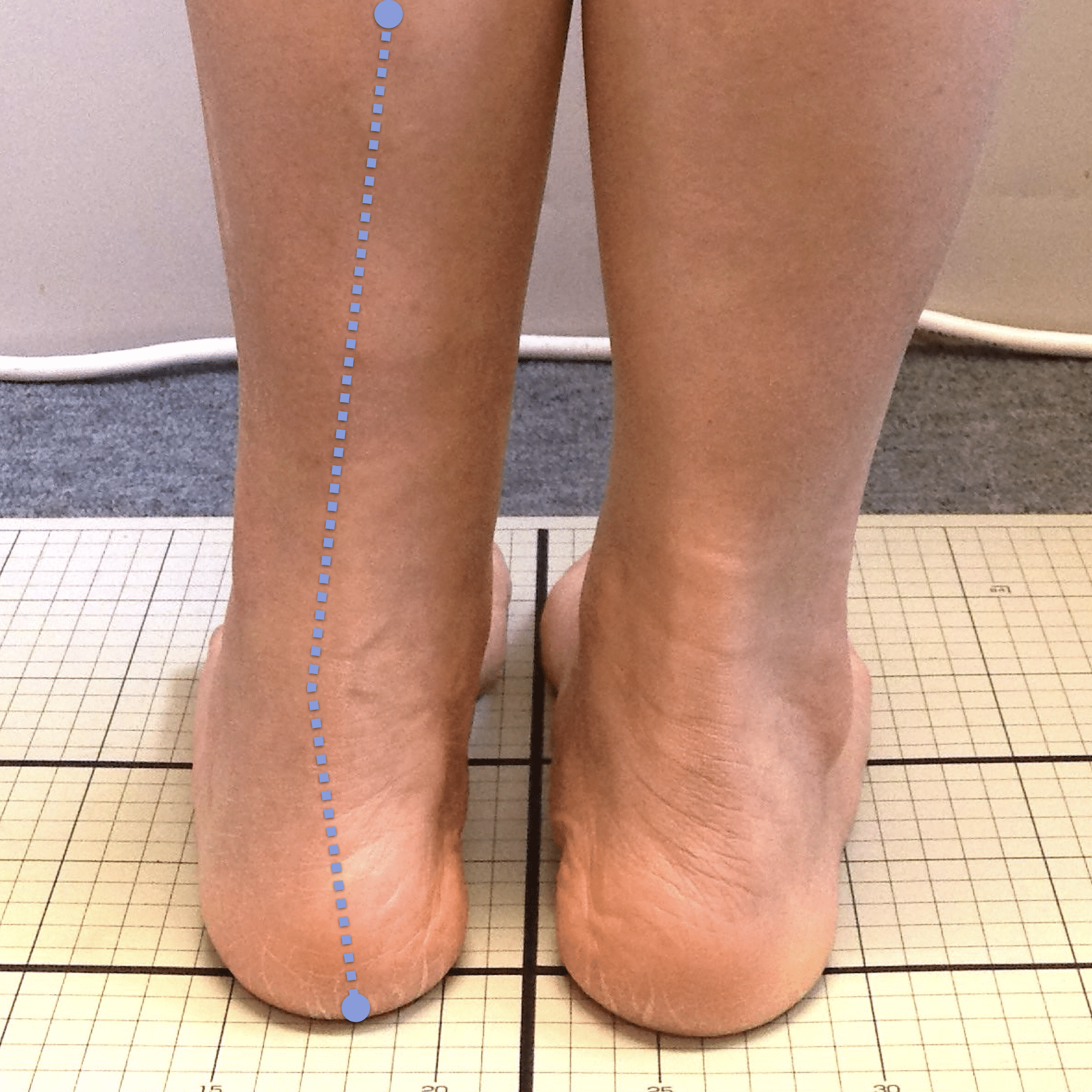
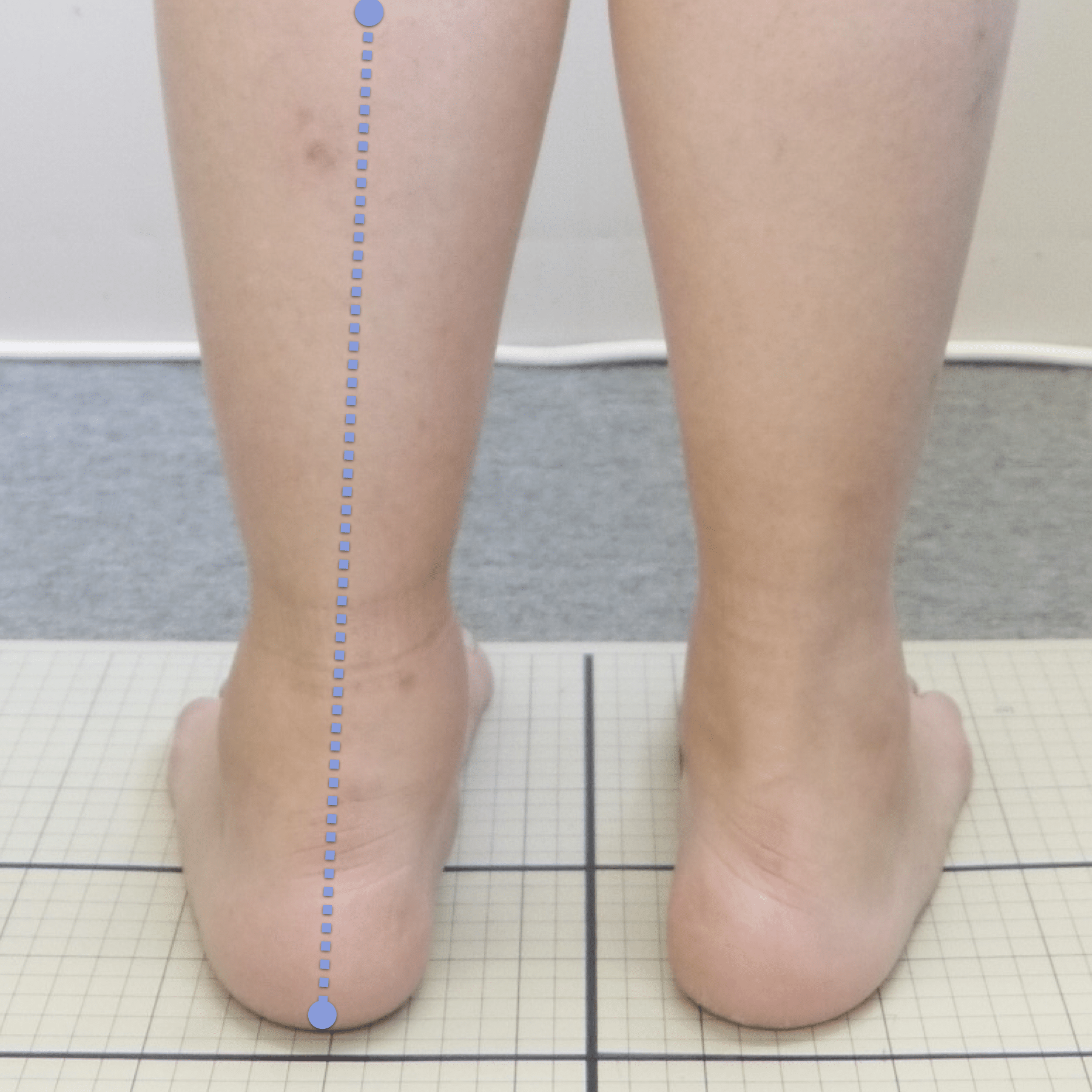
親指が使えないとX脚になる。靭帯の問題だけれども、親指が原因の可能性があるということ。
検査・セルフチェック
後十字靭帯損傷を疑う場合、以下のような症状が見られるかどうかチェックしてみてください。
1)膝の急な腫れや内出血
2)膝の安定性の低下や不安定感
3)膝を捻ると痛みが生じる
4)膝の動かし方に制限がある
5)歩行時や運動時に膝の痛みや不快感がある
6)膝の腫れや痛みが長引く
姿勢のセルフチェック
まずは骨盤から下の写真をスマホでも良いので撮影してみましょう。撮影するときには「両足をそろえる」ことに注意します。
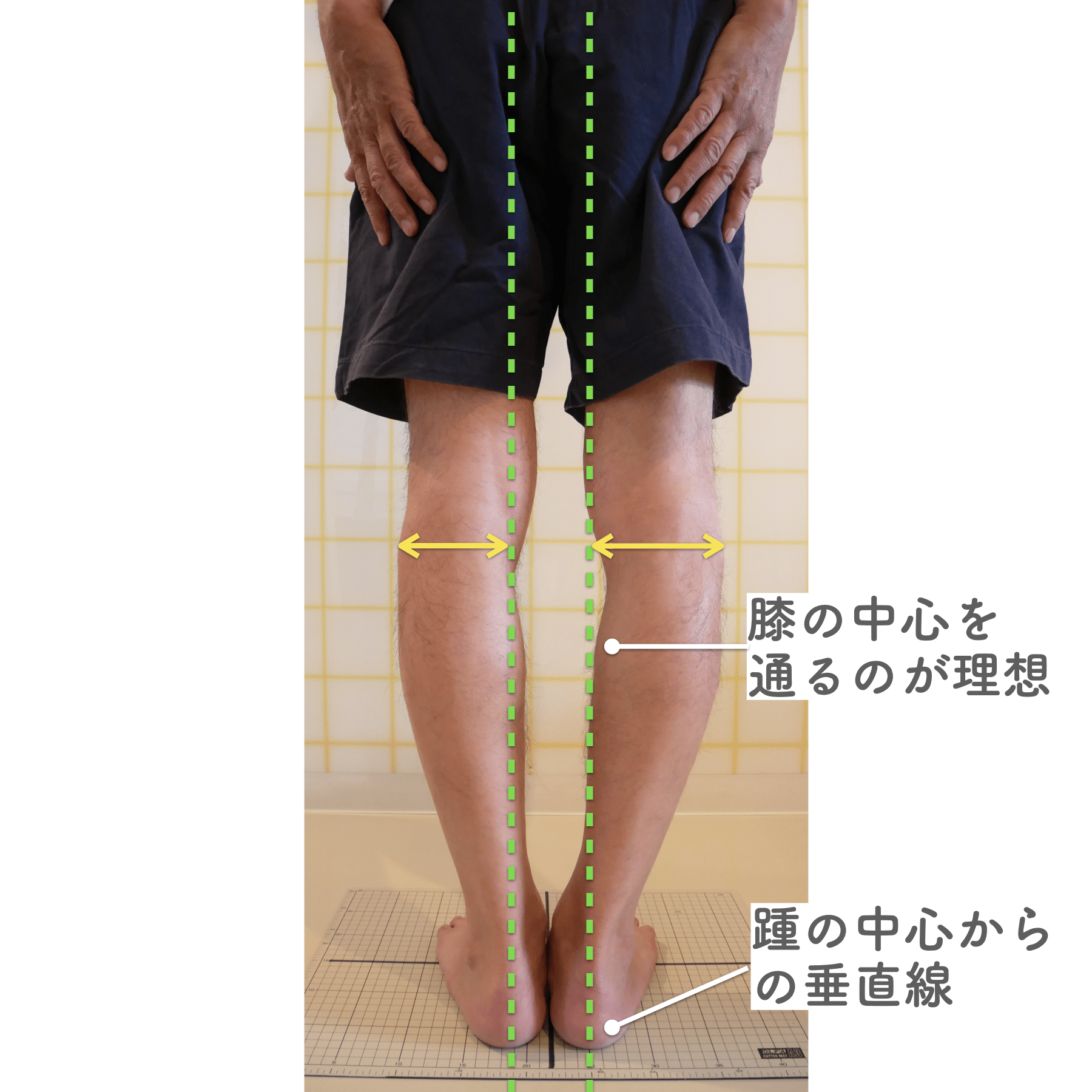
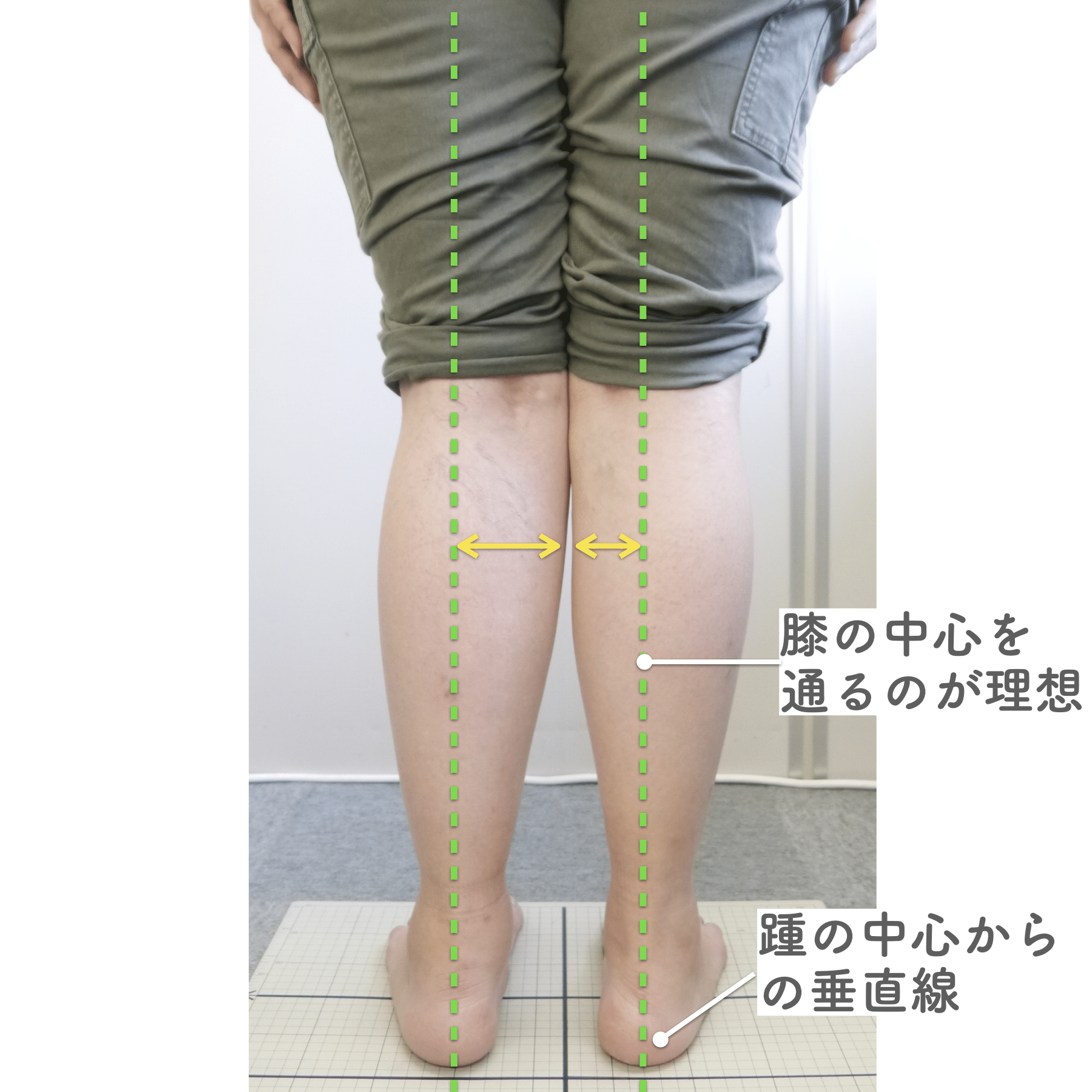
「踵の中心」から垂直線を引きます。理想的には、この線が「膝の中心」を通ります。ほとんどの人が膝の中心よりも内側や外側を通っていたのではないでしょうか?
上の写真のように両脚で通る線に左右差がある人、踵からの垂直線が膝の中心から離れれば離れるほど後十字靭帯損傷を起こしやすいと言えます。この部分については「筋力」だけでは補うことはできないので、トレーニングをどんなに頑張っても復帰できずに引退するスポーツ選手が多いのは、足指を見ていないことや膝のアライメントを考えていないからなのです。
膝の内反・外反セルフチェック
もっと簡単な方法として、寝た状態で確認するやり方があります。まずは自然な状態で寝てみましょう。ほとんどの人はつま先が外側か内側を向いていると思います。O脚の人は外側、X脚の人は内側を向いています。その時の「ひざこぞう」は真上を向いているかと思います。
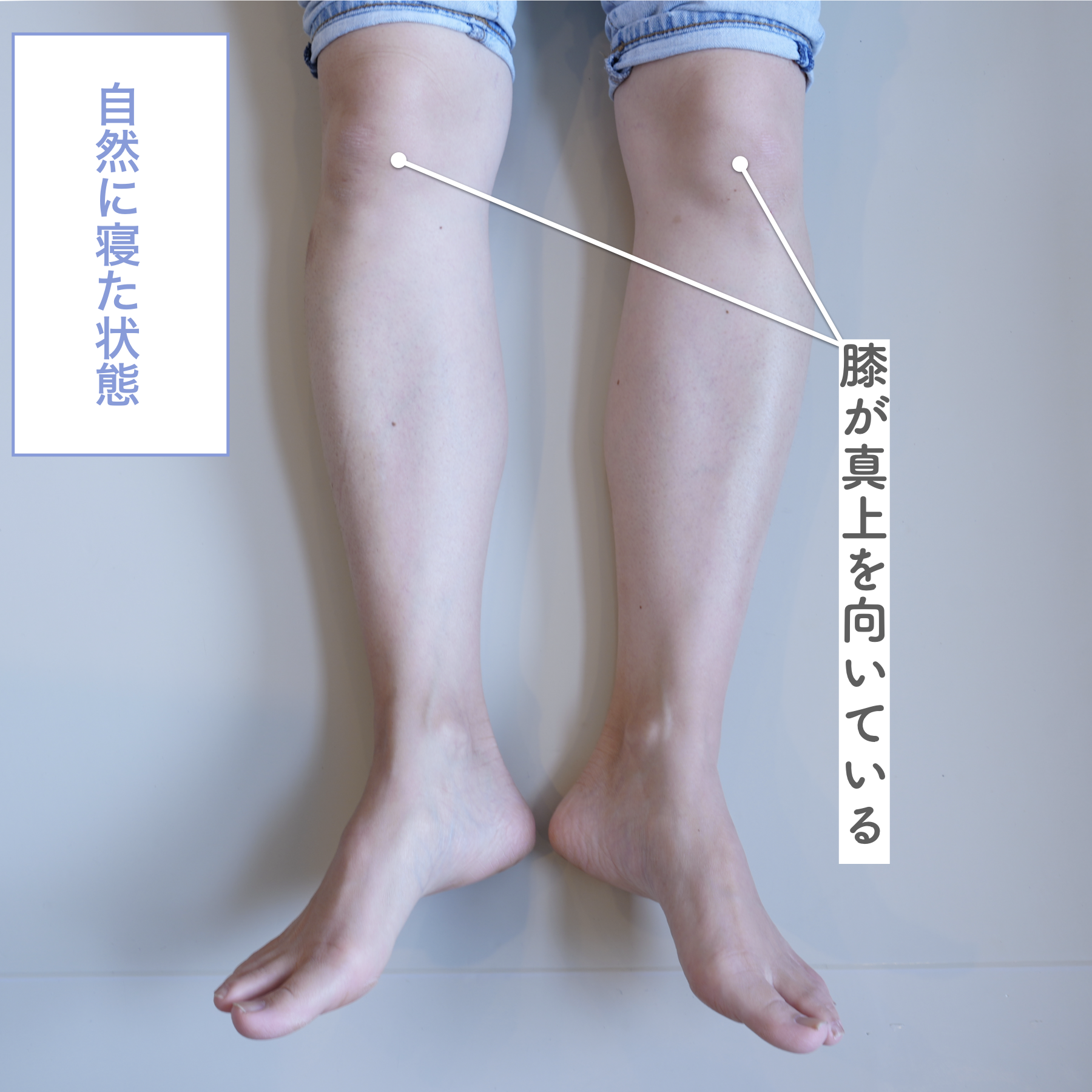
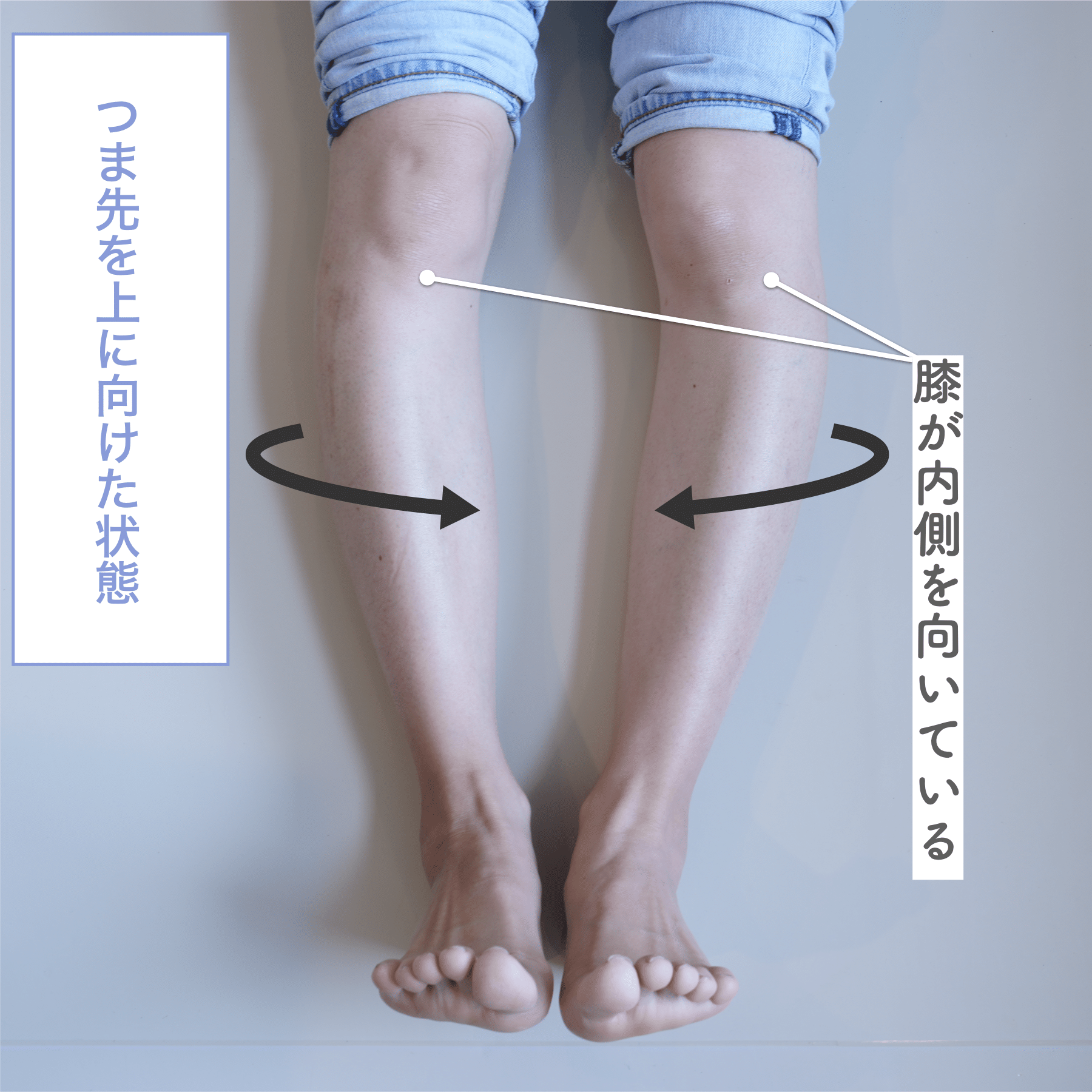
そこからつま先をまっすぐ上に向けてみましょう。ひざこぞうが内側や外側にぐるっと動くようであれば、後十字靭帯を痛めやすいほど足が変形していることになります。O脚の人は内側に、X脚の人は外側に動くと思います。
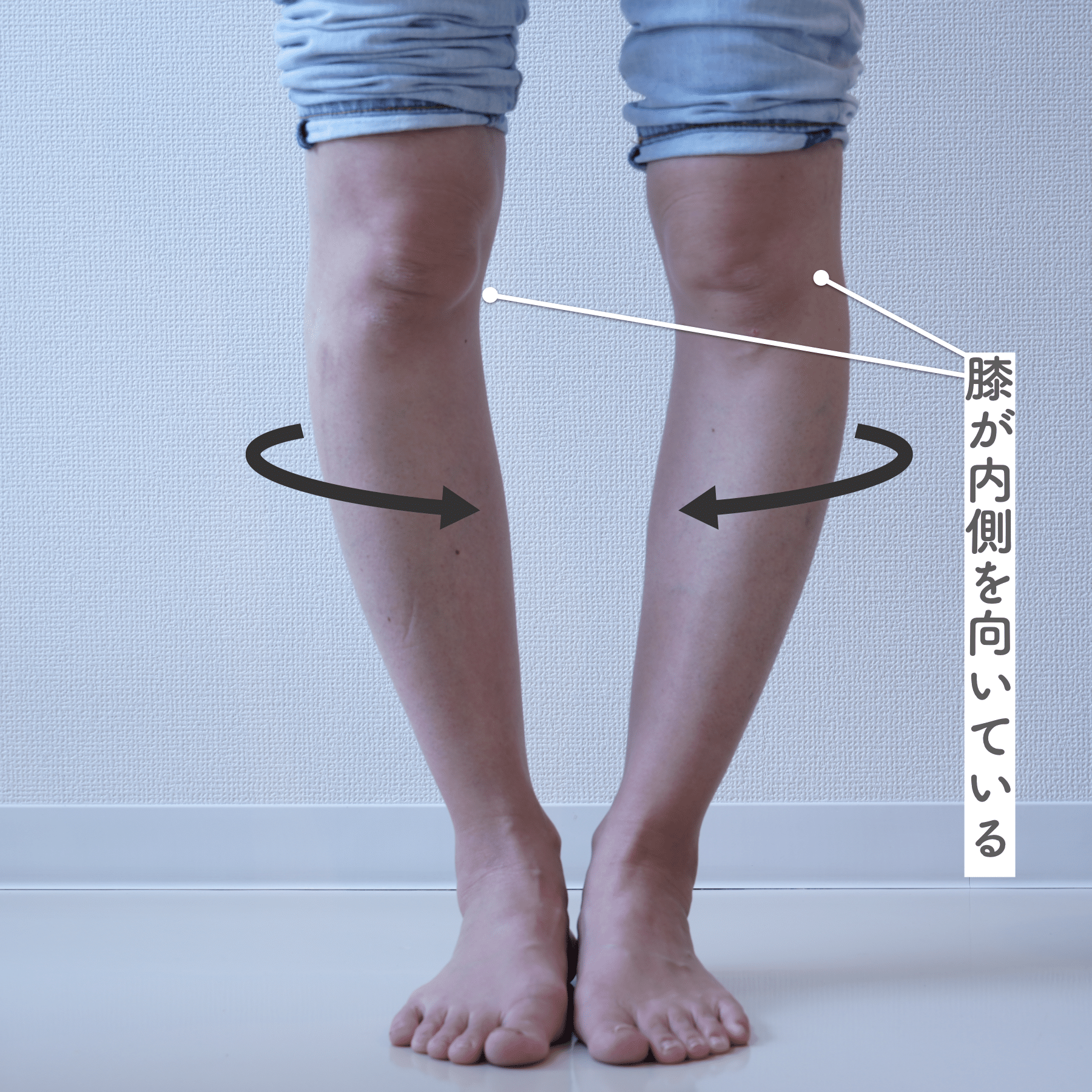
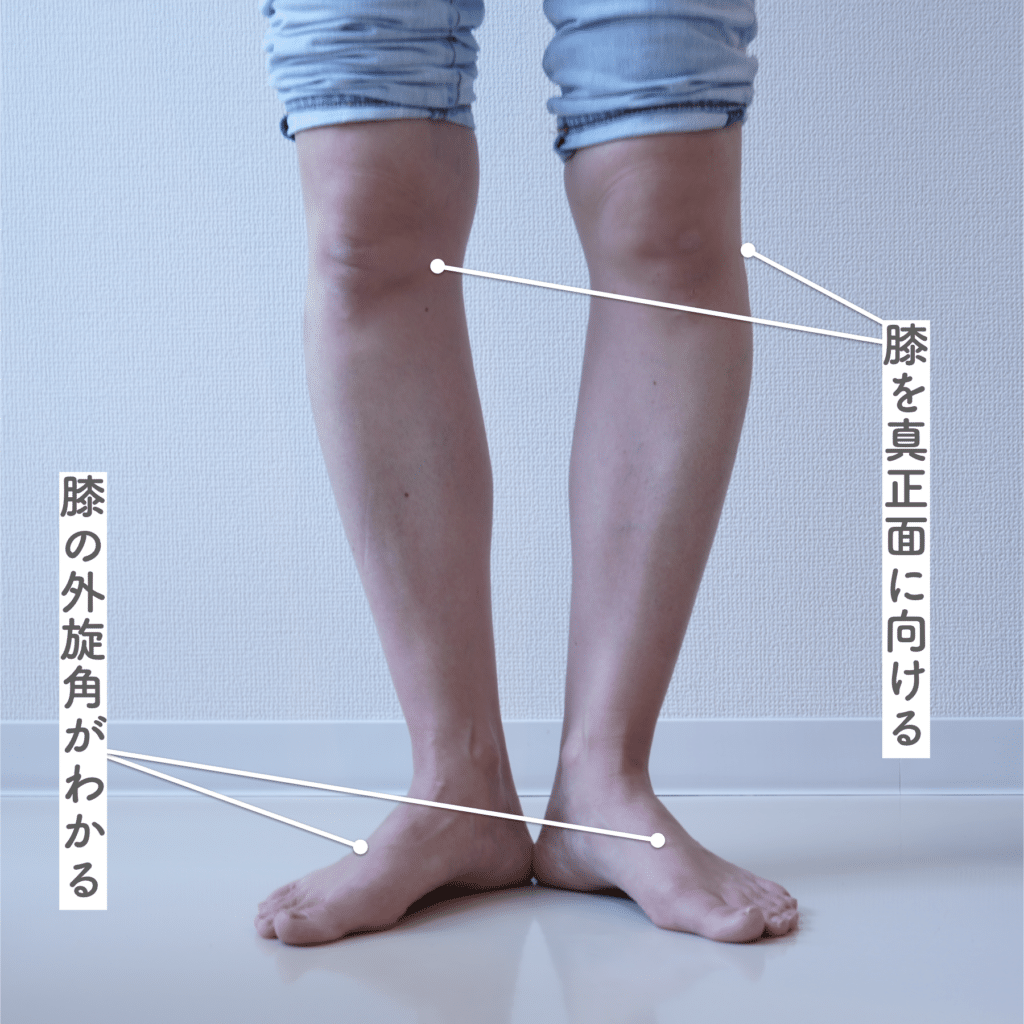
立った状態で確認するもう一つの方法は、両足を揃えて立ってみましょう。O脚の人であれば「ひざこぞう」が内側を向いていると思います。その「ひざこぞう」が真正面を向くように、踵をそろえた状態で足を外側に少しずつ開いていきます。ひらいた足の角度が45°を超えると、後十字靭帯を痛めやすいほど脚が変形しているということになります。
X脚の人であれば「ひざこぞう」が外側を向いていると思います。その「ひざこぞう」が真正面を向くように、つま先をそろえた状態で踵を外側に少しずつ開いていきます。ひらいた足の角度が45°を超えると、後十字靭帯を痛めやすいほど脚が変形しているということになります。
足指の変形セルフチェック
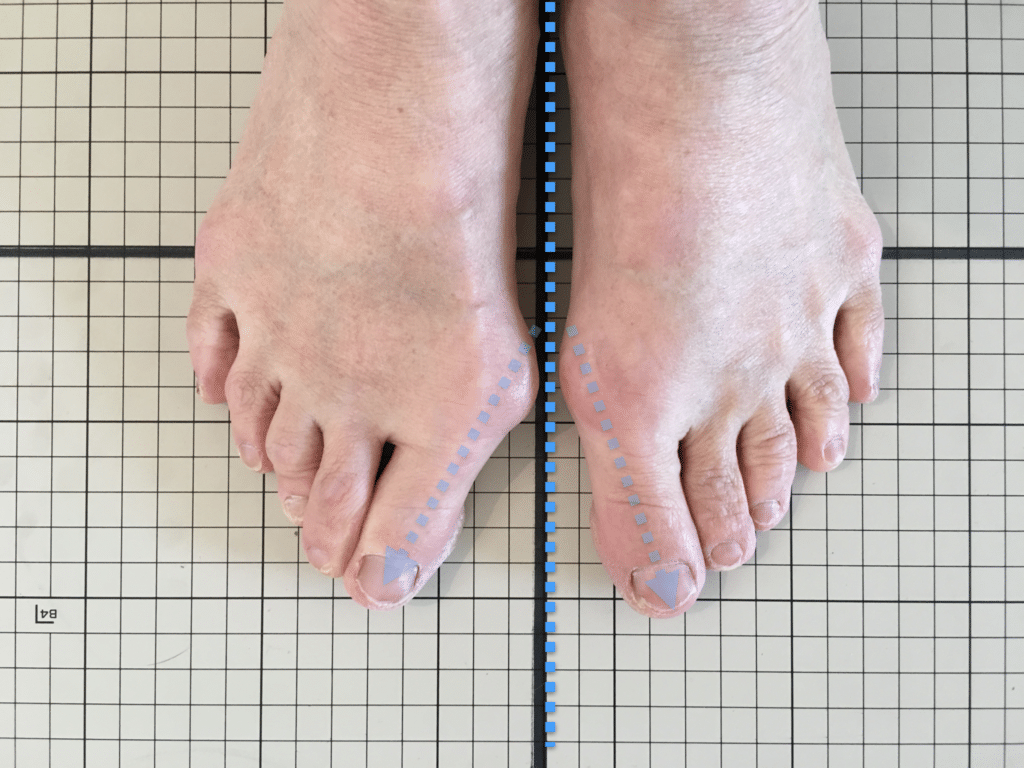
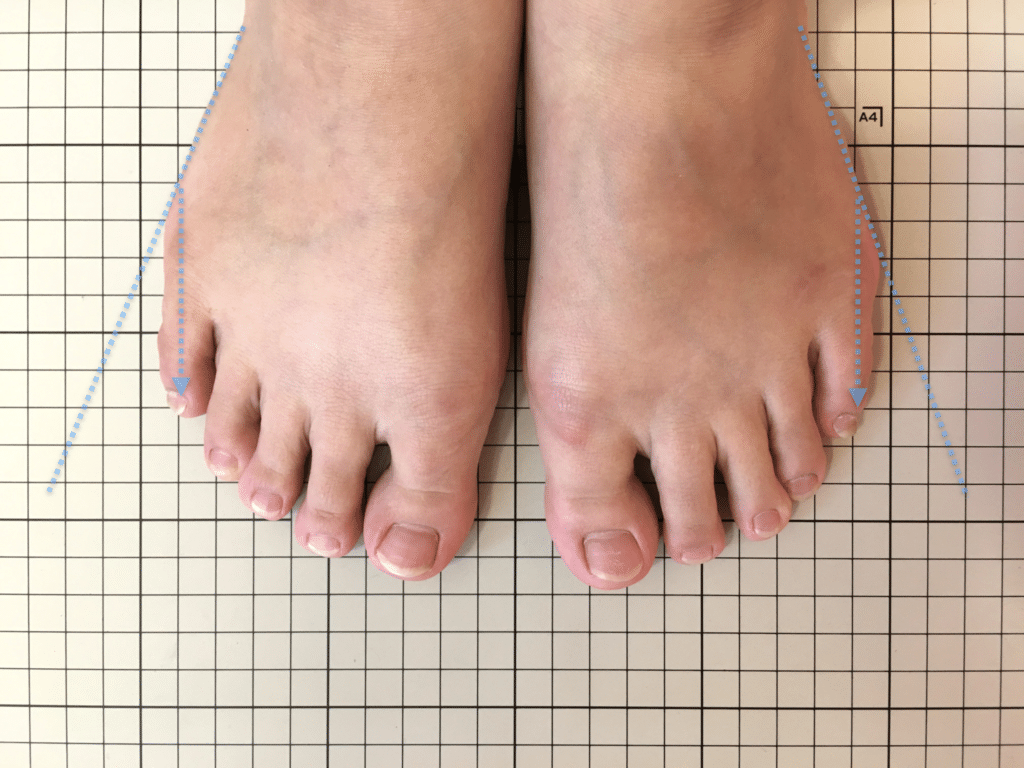
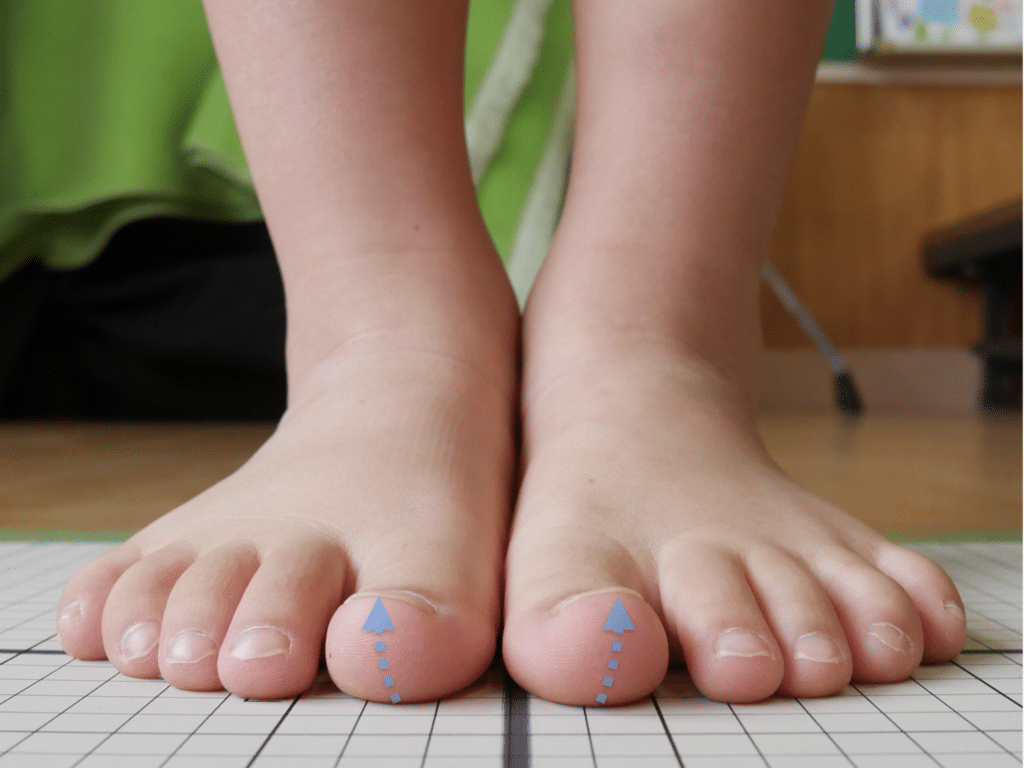
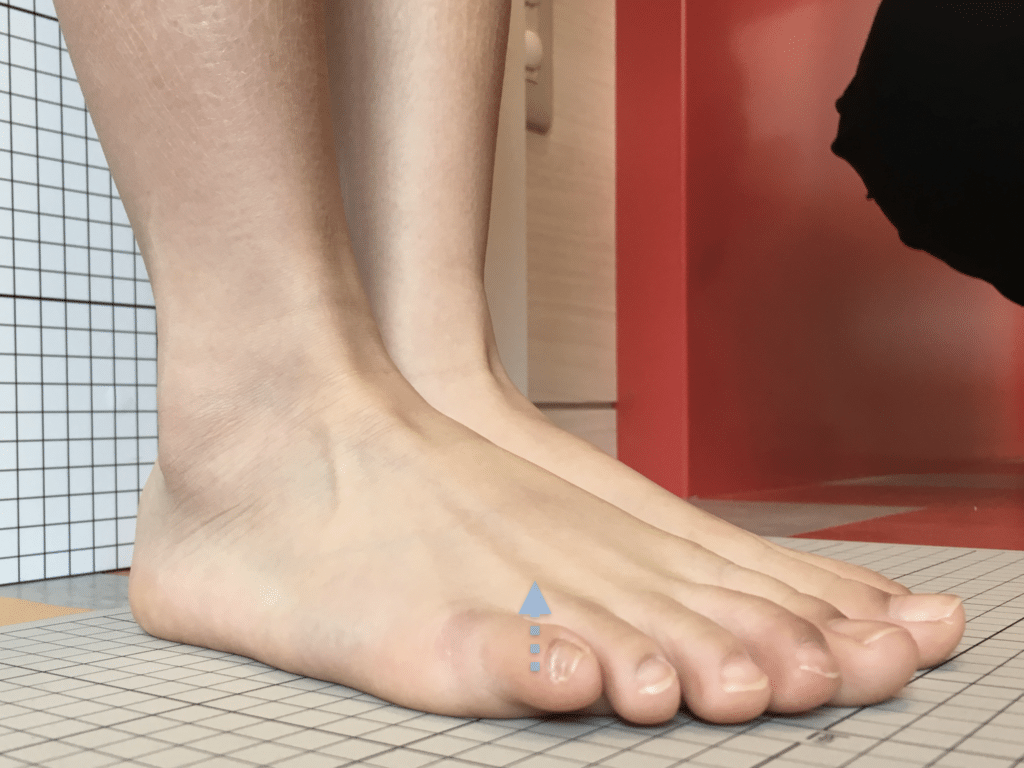
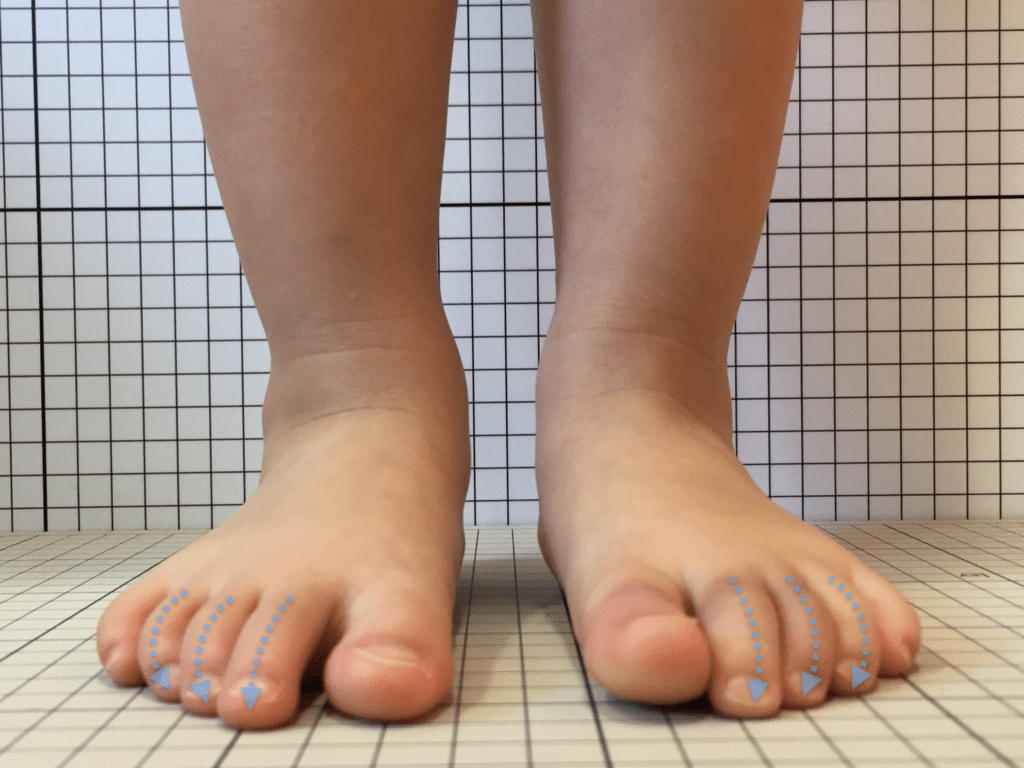
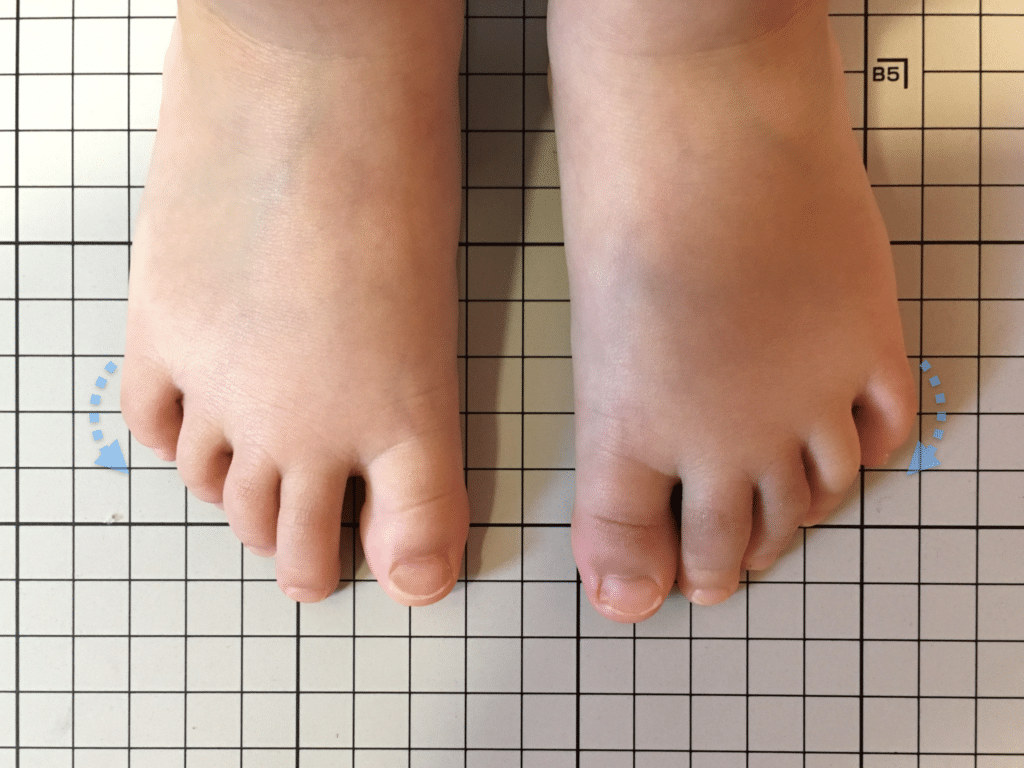
ほとんどの現代人は、間違った靴選び、すべりやすい素材の靴下などによって足指が変形し、土台が崩れています。詳細は以下のサイトに記載しているので参考にされてください。これまでオリンピック選手、世界陸上選手、プロ野球選手、プロサッカー選手など数多く見てきましたが、足指の変形がひどい人ほど、故障をしやすいです。
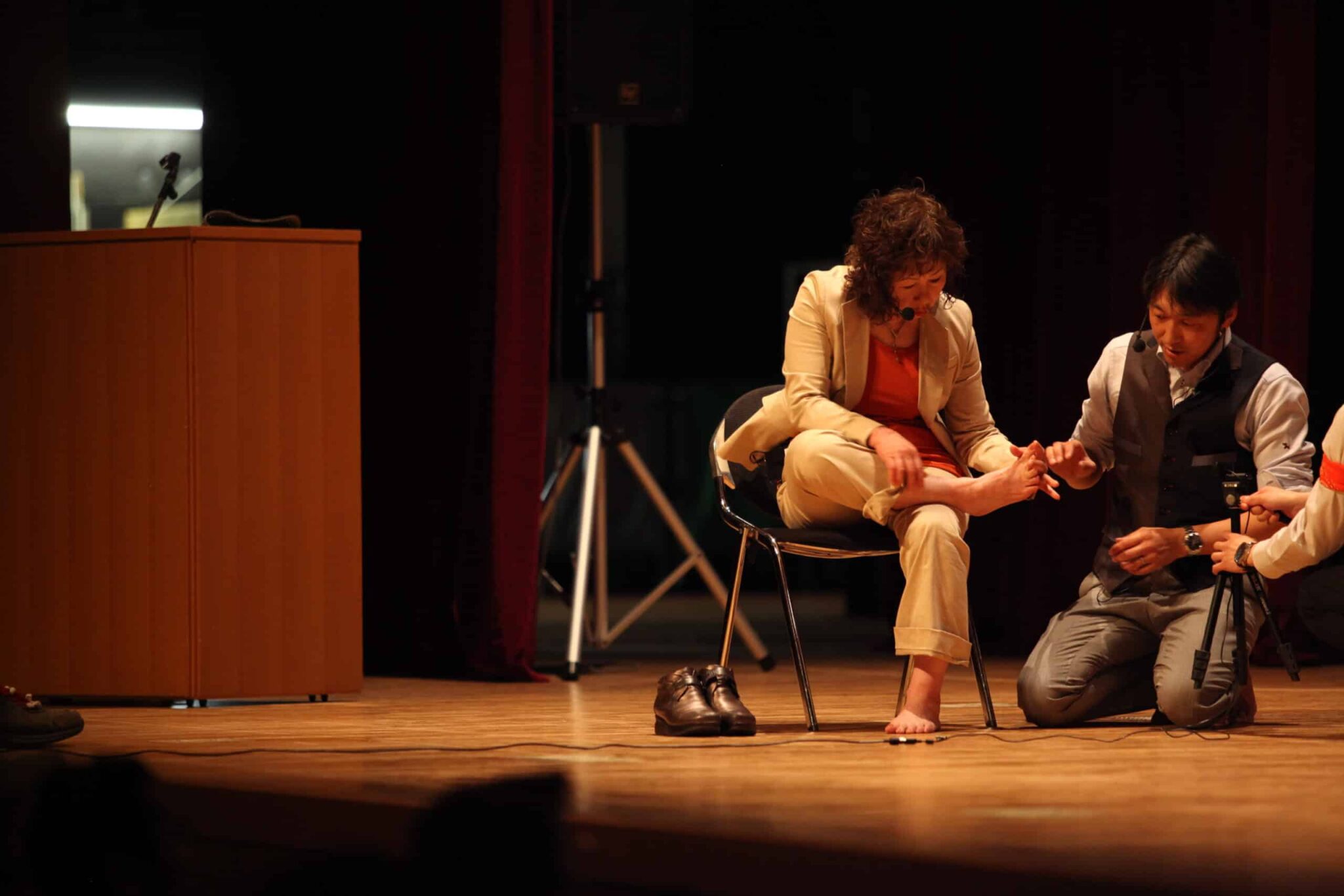
足指変形セルフチェックシート
X脚の人は、簡易的に親指の変形を確認できるチェックシートも用意しています。ダウンロードをして、自分の足を乗せて確認してみてください。
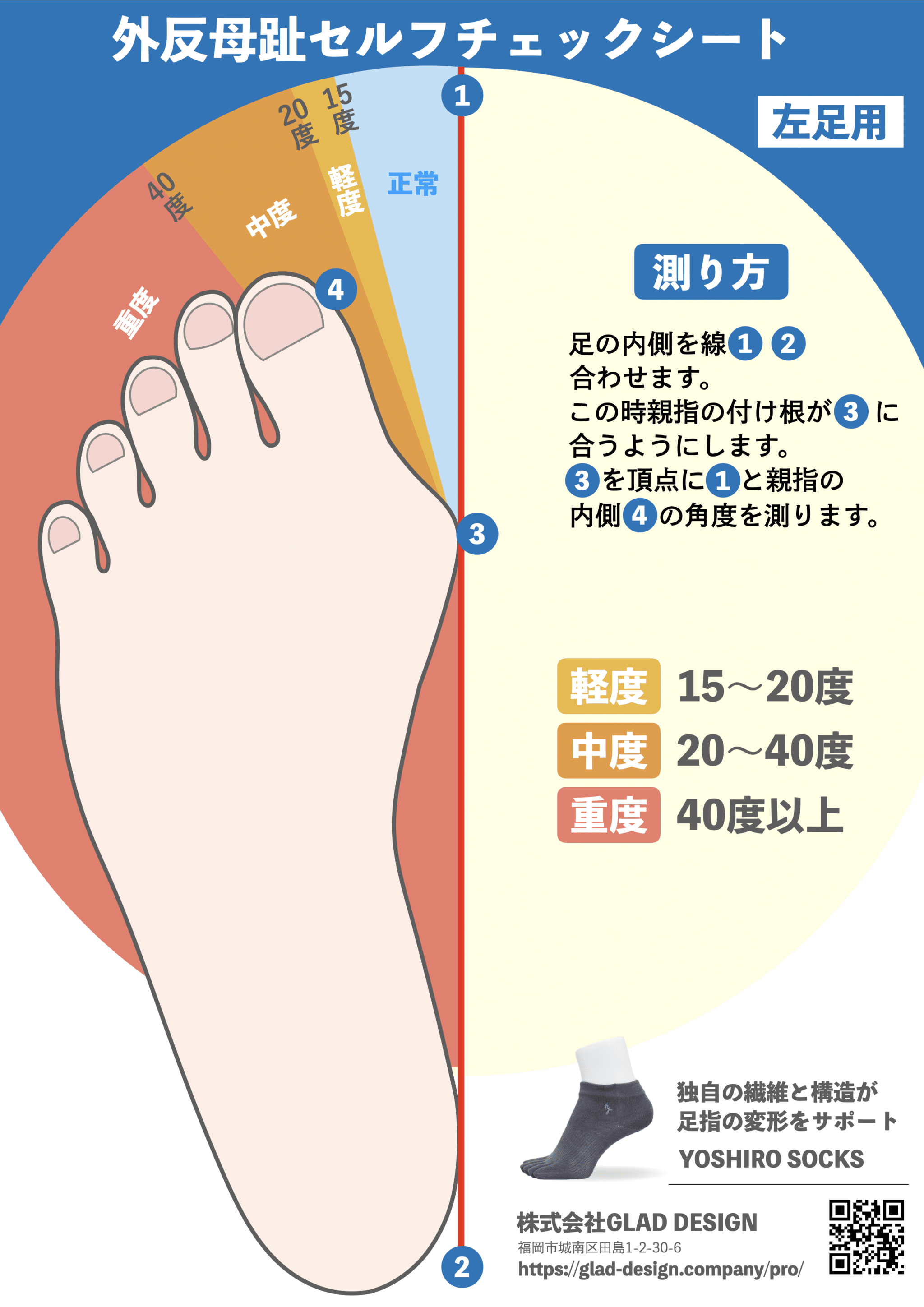
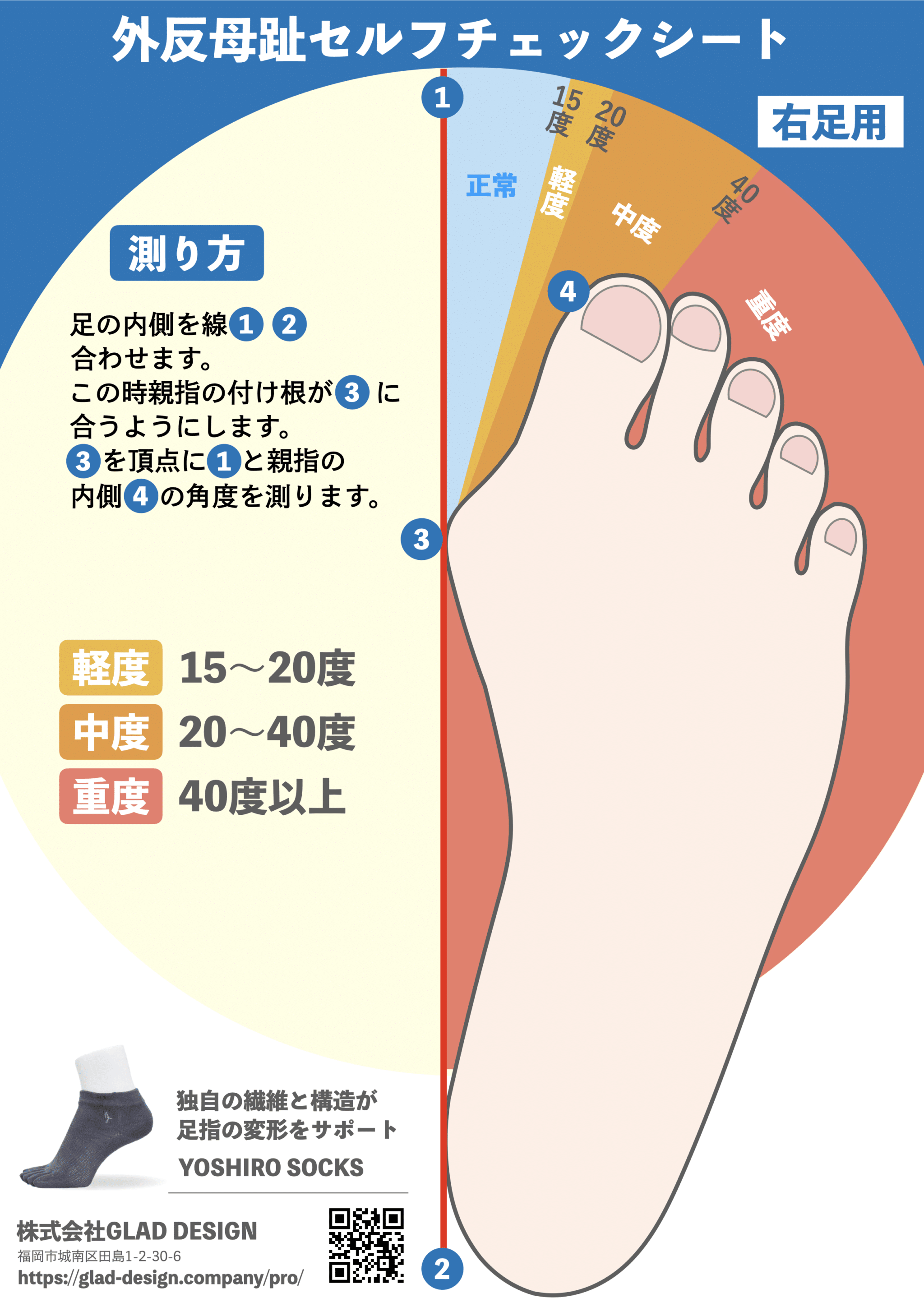
O脚の人は、簡易的に小指の変形を確認できるチェックシートも用意しています。ダウンロードをして、自分の足を乗せて確認してみてください。
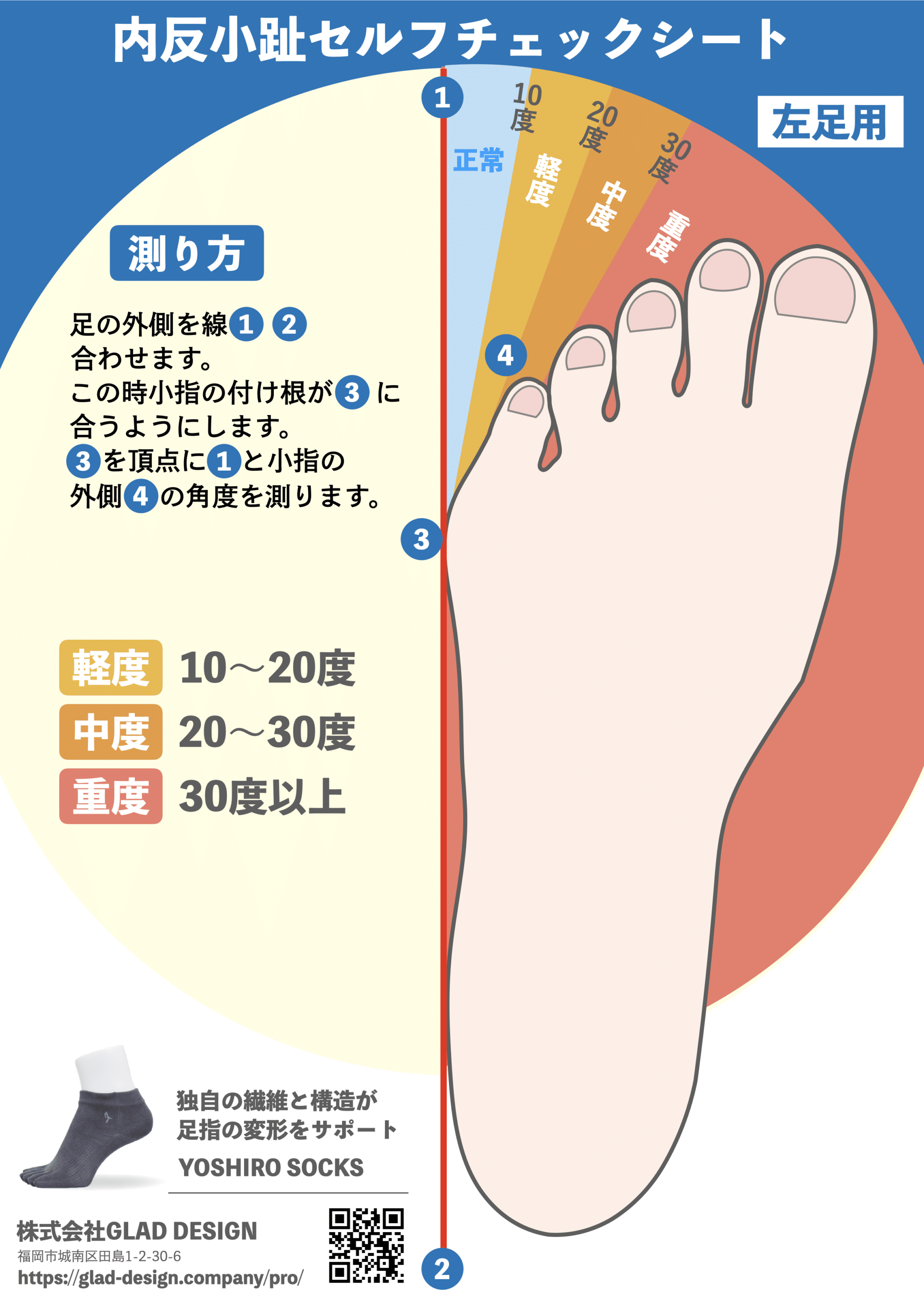

治療
後十字靭帯損傷の治療法は、損傷の程度や症状によって異なりますが、一般的に以下の方法が行われます。下記の治療(保存療法)は一時的に症状が緩和することもありますが、再発を繰り返すことが少なくありません。
1)保存療法:腫れや炎症を抑えるために、安静を保ち、氷や湿布で患部を冷やすことが大切です。
2)牽引療法:靭帯を保護するために、膝を安定させるための装具や固定具を使用します。
3)筋力トレーニング:周囲の筋肉を強化することで、患部の負担を軽減し、靱帯の再建を助けることができます。
4)レストリクションアクティビティ:過度な負荷をかけないように、患部を保護するために運動や活動を制限することが必要です。
5)理学療法:専門家によるケガの一般的な治療法であり、靭帯を強化し再建する目的で使用されます。
6)手術:重度の後十字靭帯損傷の場合は、手術が必要になることもあります。手術には内視鏡手術や開放手術などがあります。
後十字靭帯損傷の治療には多くの場合、手術療法で良好な結果が得られますが、再発させずに根治させるには足指ケアを行い、O脚やX脚を改善させることで膝の内側に負担をかけず、後十字靭帯に過度のストレスをかからないようにすることが大切です。
基本的に靭帯は強化することができません。しかし、これまでの説明で「靭帯に張力を発生させない」ことが重要であることがわかったのではないでしょうか?何をしても効果を感じられなかったという人は、足指の機能を取り戻し、脚の変形をニュートラルポジションに戻すことをはじめてみてください。
断裂した靭帯の手術は良いけど、その後に足指を使えるようにしないと再発するよ、ということ。
後十字靭帯損傷を起こさないためのトレーニング法
脚の変形が後十字靭帯損傷を起こすことがあることがわかったでしょうか?後十字靭帯は膝の安定性を保つ重要な靭帯の一つであり、急激な方向転換や過度のストレスがかかると損傷することがあります。脚の変形によって足首や膝が正常な位置にならず、関節に過度の負荷がかかることで後十字靭帯に損傷が生じる可能性があります。そのため、後十字靭帯への負荷を最小限にするために、足と脚のアライメントを整えるが足指トレーニングなのです。
O脚やX脚を改善する足指ストレッチ「ひろのば体操」
1日1回5分を目安にやってみましょう。2〜3日やってみて症状に変化が見られないときは、1日2〜3回に回数を増やしてみることをお勧めします。目標は足指のパーが30秒間できるようになることです。再発を繰り返す人は1日に30分を目安に行うことを推奨しています。
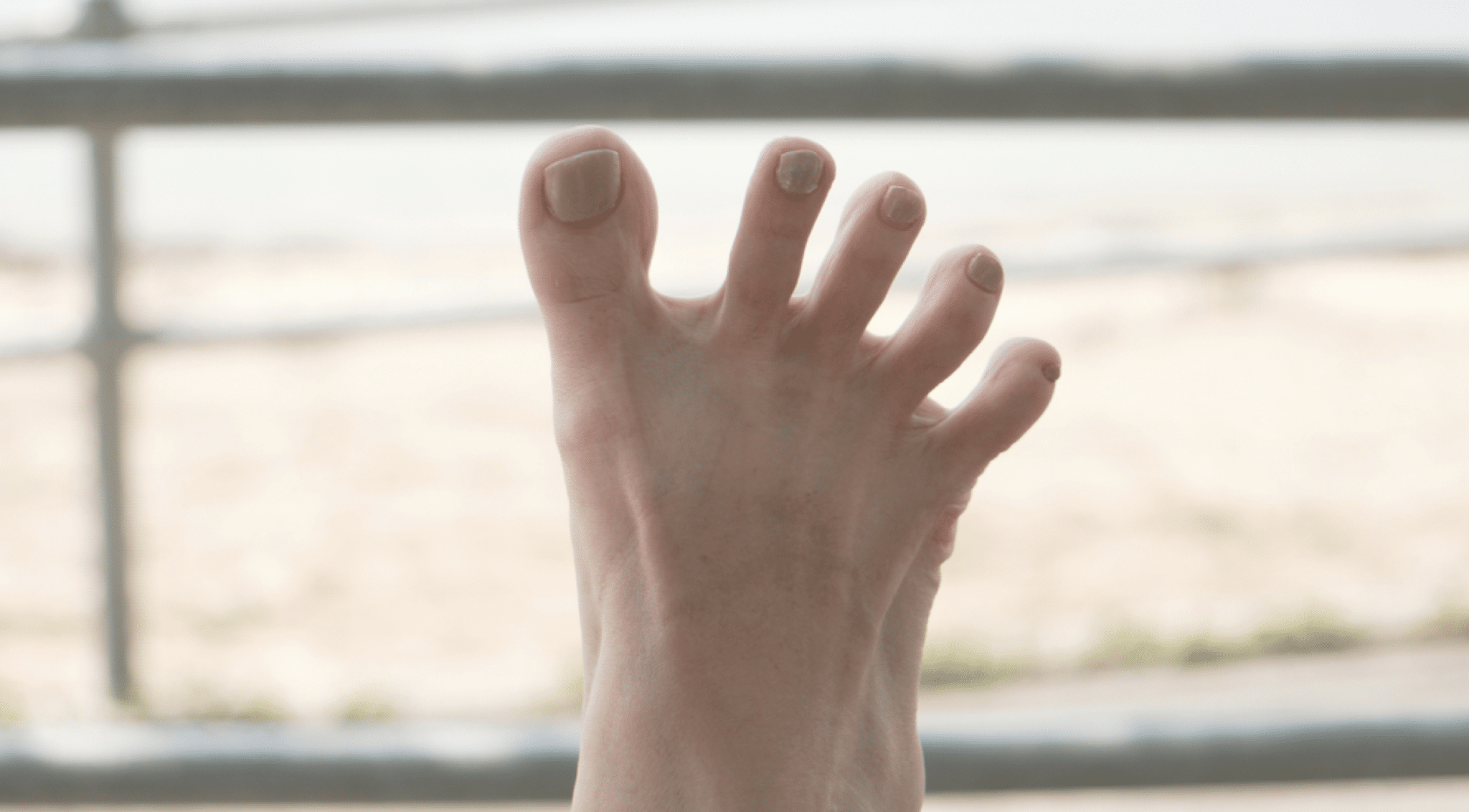
O脚やX脚を最適にサポートする矯正5本指靴下
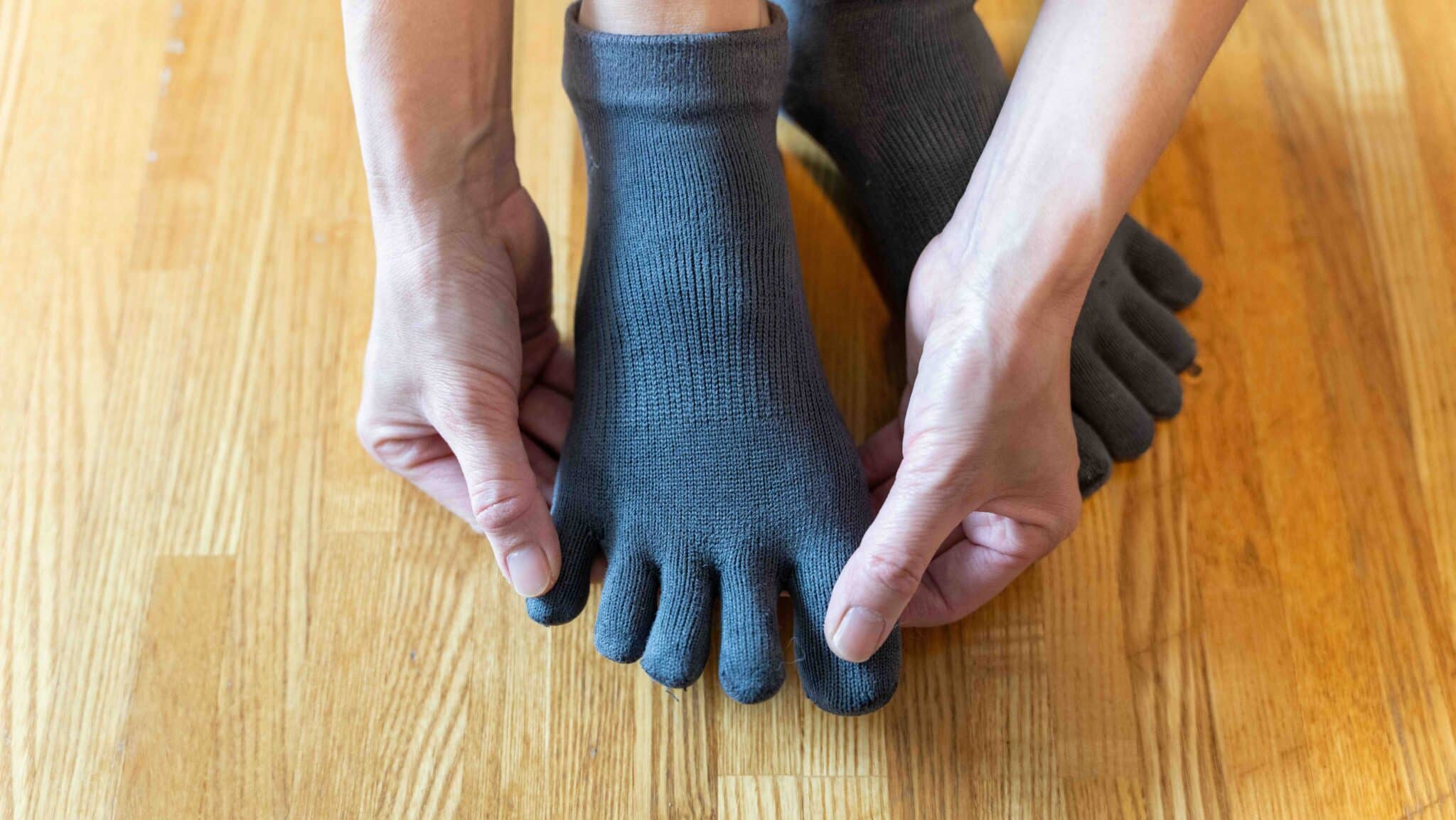
これまで綿やシルクで機能性5本指靴下を製作し、臨床現場で多くの患者様に試してきましたが、靴や靴下の中で足が滑るという問題を解決することができませんでした。そこで、繊維会社と2年の歳月をかけて理想的な繊維を完成させ、矯正5本指靴下「YOSHIRO SOCKS」が誕生しました。後十字靭帯損傷に悩んでいる方は、試してみてください。
純綿やシルク素材のものは滑りやすい
シルケット加工(またはマーセライズ加工)というものがあります。シルケット加工とは、シルクの様な光沢を持たせる加工のことで、糸を苛性ソーダ(水酸化ナトリウム)の液に浸し、手延べうどんのように糸を伸ばして糸の断面を整える加工のこと。主に綿やシルク繊維(コットン)に対して加工をすることが圧倒的に多いです。
綿の断面が整い発色性もよくなり、加工をすると毛羽も抑えられるため、見た目に高級感があります。なめらかですべるような履き心地なのですが、なめらか(滑らか)ですべる(滑る)というように読んで字が如く、靴の中や靴下の中で足が滑りやすくなります。つまりは足指の変形を起こしやすい素材ということなのです。
もちろんシルケット加工をしていない綿やシルク素材もありますので、そういった素材を選ぶこともひざ痛の予防には大切な要素です。
5本指靴下で足指の機能を発揮させる
一般的な靴下はチューブソックスとも呼ばれ、世界中の方のほとんどがこのタイプの靴下です。長年使われてきた形状なのですが、チューブタイプは足指をうまく使うことができなくなります。そのため5本に分かれた靴下が良いのですが、このタイプにも色々なものがあります。
一番大切にしたいのは、自分自身の足にジャストフィットするか。指先や甲まわりがゆるかったりすると、せっかくの5本指靴下でも「滑り」が発生してしまいます。逆にフィットしすぎて圧迫感を感じる5本指靴下も血行を妨げてしまうためオススメできません。自分が使ってみて「心地よい」と感じる5本指靴下を見つけることが大切です。
また、アーチをサポートすることは大切なのですが、アーチ構造というのは強く持ち上げすぎると機能を失ってしまう特性があるので、アーチ部分もあまり圧迫感がないものを選ぶようにしましょう。
正しい靴の選び方
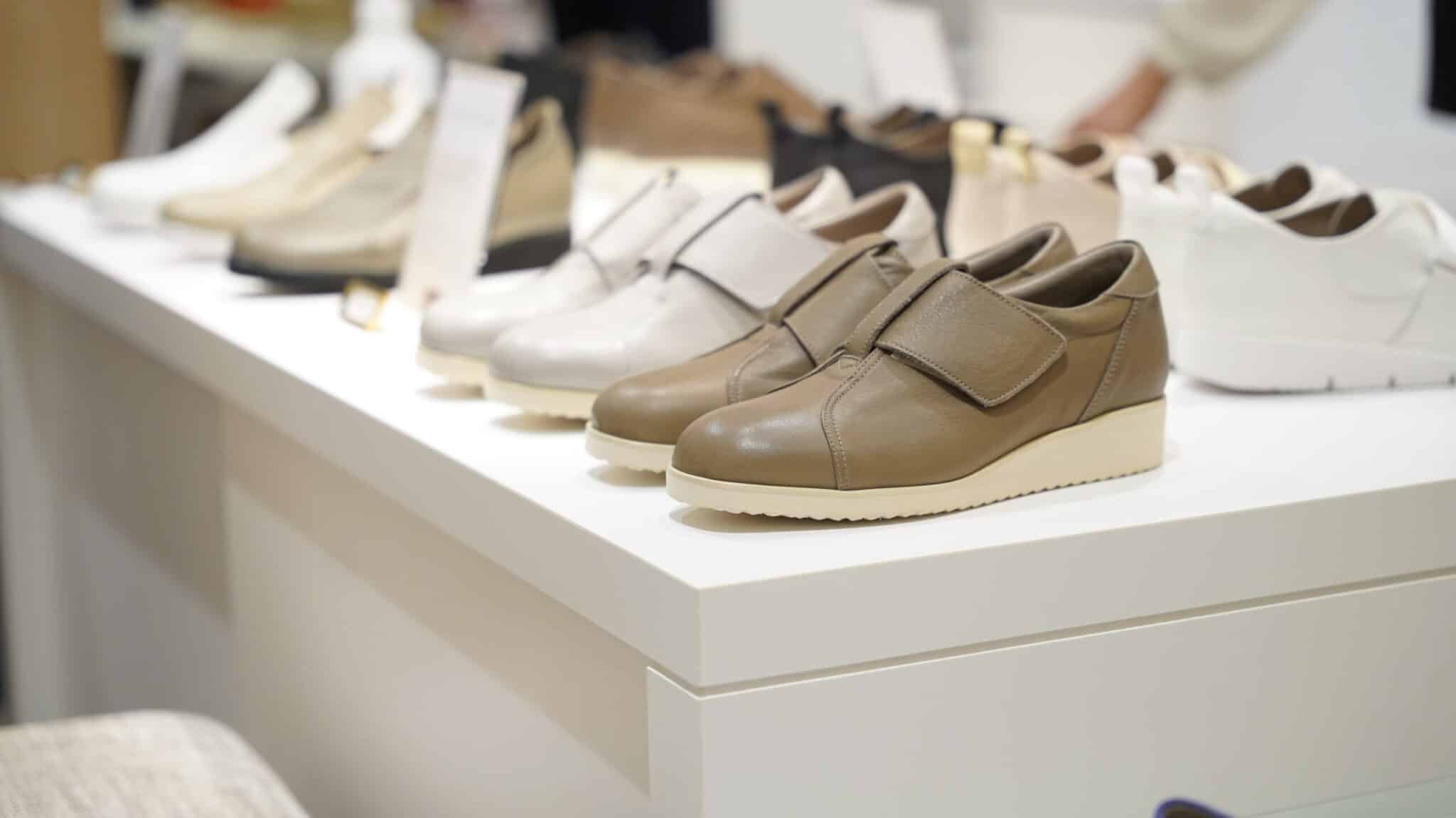
足指が変形するいちばんの原因は、靴の選び方と履き方にあります。背骨のトラブルの多くは、足の指をちゃんと使っていないことが原因です。足と方は遠く離れた場所にあるので、ピンとくる人は少ないと思います。「風が吹けば桶屋が儲かる」ではないですが、足先から頭までカラダは全てつながっているので、後十字靭帯損傷で悩まれている方はこの機会に足元を見直してみてください。
適度なウォーキングが後十字靭帯への負担を軽減する
より効果的にするために
足指ストレッチや矯正5本指靴下(YOSHIRO SOCKS)を履きながら、日常生活を少し変えることで、姿勢を正しい状態で保持し、後十字靭帯損傷を改善させ、再発を予防することができます。正しい姿勢は、正しい筋肉によって作られていきます。正しい筋肉は「足指を広げて伸ばした状態」で歩くことでしか作ることができません。
・小股で歩くようにする
・坂道や階段を上るなど足指先を使う
・室内で履き物を履かないようにする
・1日6,000歩以上歩くように心がける
・靴紐をしっかり絞めるようにする
・オーダーの枕やマットを使わない
・正しい靴選びを心がける
・靴べらを使って靴を履くようにする
足指のストレッチや矯正5本指靴下(YOSHIRO SOCKS)を履いて歩くことで、足指を機能的に使うことができます。①足指変形が改善→③重心が中心に→④O脚・X脚が改善→⑤脚長差が改善→⑥後十字靭帯へのストレスが改善という流れです。
参考文献
1. 外反母趾の機能解剖学的病態把握と理学療法.湯浅慶朗.理学療法 第31巻 第2号 2014.2 P159-165
2.『足指をそらすと健康になる』湯浅慶朗/著 PHP研究所 2014.6
3.『たった5分の「足指つかみ」で腰も背中も一生まがらない!』湯浅慶朗/著 PHP研究所 2021.6
4.Bedi A, Musahl V, Cowan JB. Management of Posterior Cruciate Ligament Injuries: An Evidence-Based Review. Journal of the American Academy of Orthopedic Surgery. 2016 May;24(5):277-89. Accessed 7/26/21.
5.Itälä A, Lankinen P, Pajulo O. Kasvuikäisten takaristisidevammat. Treatment of posterior cruciate ligament injury in skeletally immature patients. Duodecim. 2015;131(11):1085-9. Finnish. Accessed 7/26/21.
6.Schüttler KF, Ziring E, Ruchholtz S, Efe T. Verletzungen des hinteren Kreuzbands [Posterior cruciate ligament injuries]. Unfallchirurg. 2017 Jan;120(1):55-68. German. Accessed 7/26/21.

